
Chemistry, 7e (McMurry/Fay)
Chapter 1 Chemical Tools: Experimentation and Measurement
1.1 Multiple-Choice Questions
1) A consistent explanation of known observations is called
A) an experiment.
B) a hypothesis.
C) a prediction.
D) a theory.
2) An interpretation of the results of many tests is called
A) an experiment.
B) a hypothesis.
C) a prediction.
D) a theory.
3) Which of the following is an example of a qualitative measurement?
A) blue crystal
B) 10 g of salt
C) 2 moles of carbon atoms
D) 12 dL of water
4) What symbol is used to express the factor, 10-6?
A) M
B) m
C) μ
D) n
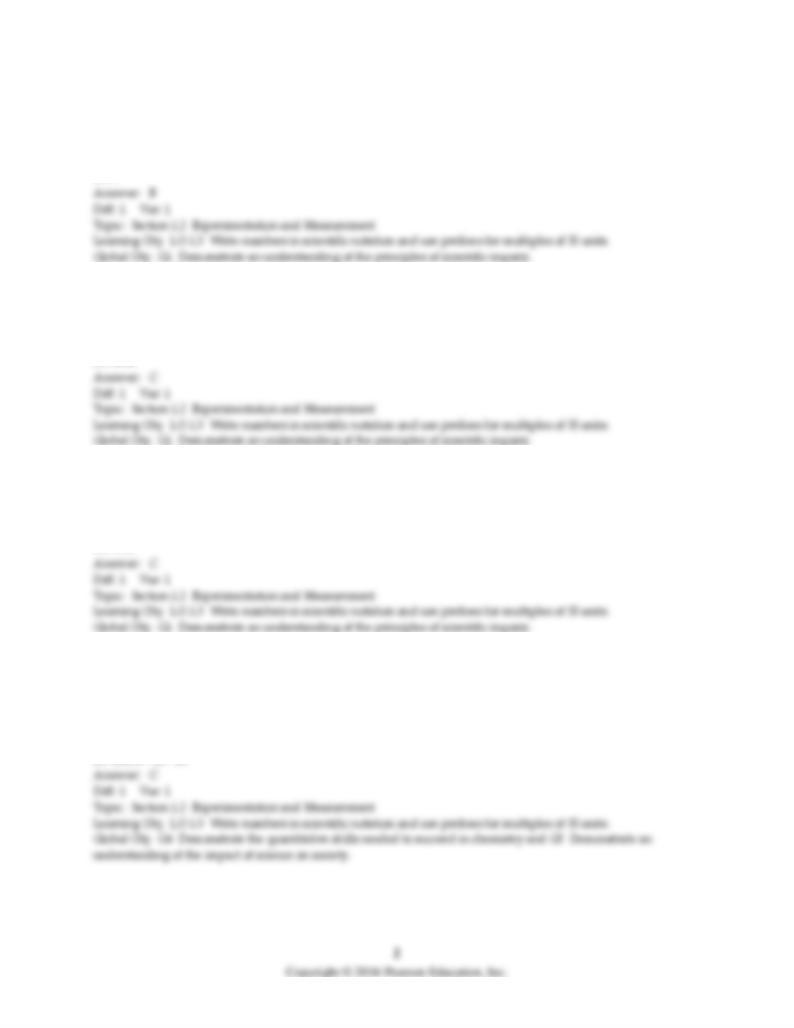
5) What symbol is used to represent the factor 10-3?
A) M
B) m
C) μ
D) n
6) The factor 0.01 corresponds to which prefix?
A) deka
B) deci
C) centi
D) milli
7) The factor 10-2 corresponds to which prefix?
A) deka
B) deci
C) centi
D) milli
8) A sailor circumnavigated the earth and covered 4,264,000 meters. Express this number in standard
scientific notation.
A) 4.264 × 10-7 m
B) 4.264 × 10-6 m
C) 4.264 × 106 m
D) 4.264 × 107 m
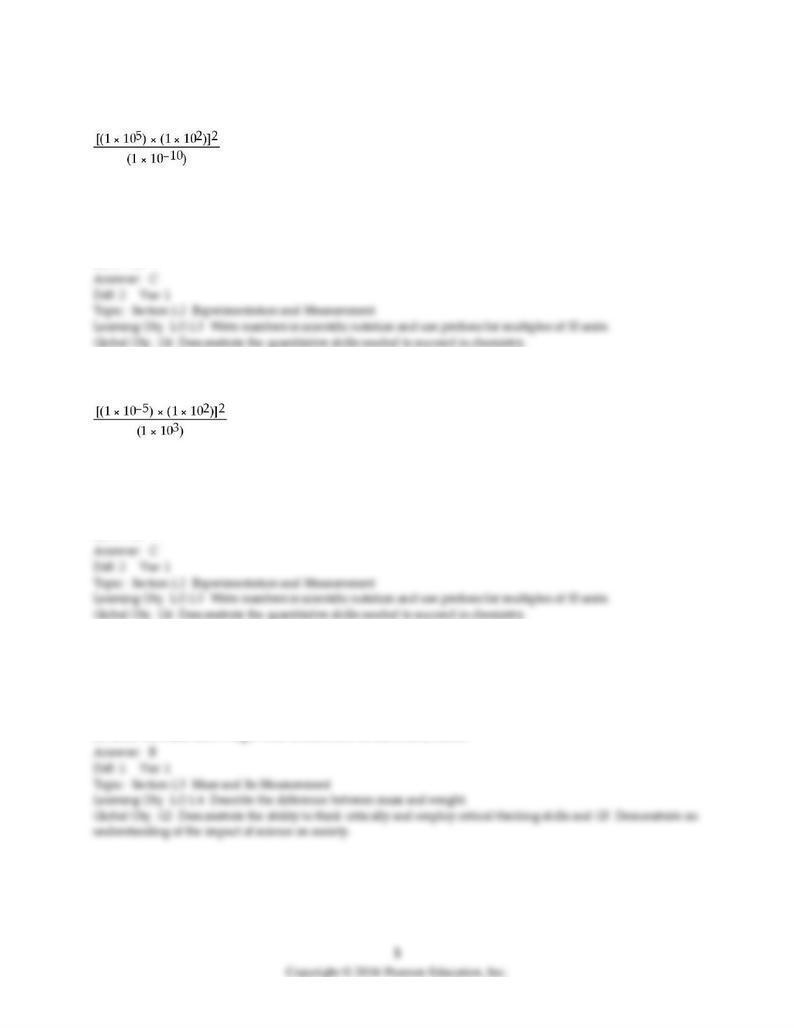
9) Without using a calculator, solve the following problem:
A) 1 × 10-6
B) 1 × 104
C) 1 × 1024
D) 1 × 1034
10) Without using a calculator, solve the following problem:
A) 1 × 100
B) 1 × 10-3
C) 1 × 10-9
D) 1 × 10-12
11) An astronaut uses a laboratory balance and weighs an object on earth and again on the moon. Which
statement below about the weight and mass of the object is true?
A) The mass and weight will be identical on the earth and the moon.
B) The mass will be the same on earth and moon but the weight will be less on the moon.
C) The weight will be the same on earth and moon but the mass will be less on the moon.
D) Both the mass and weight will be different on earth and moon.
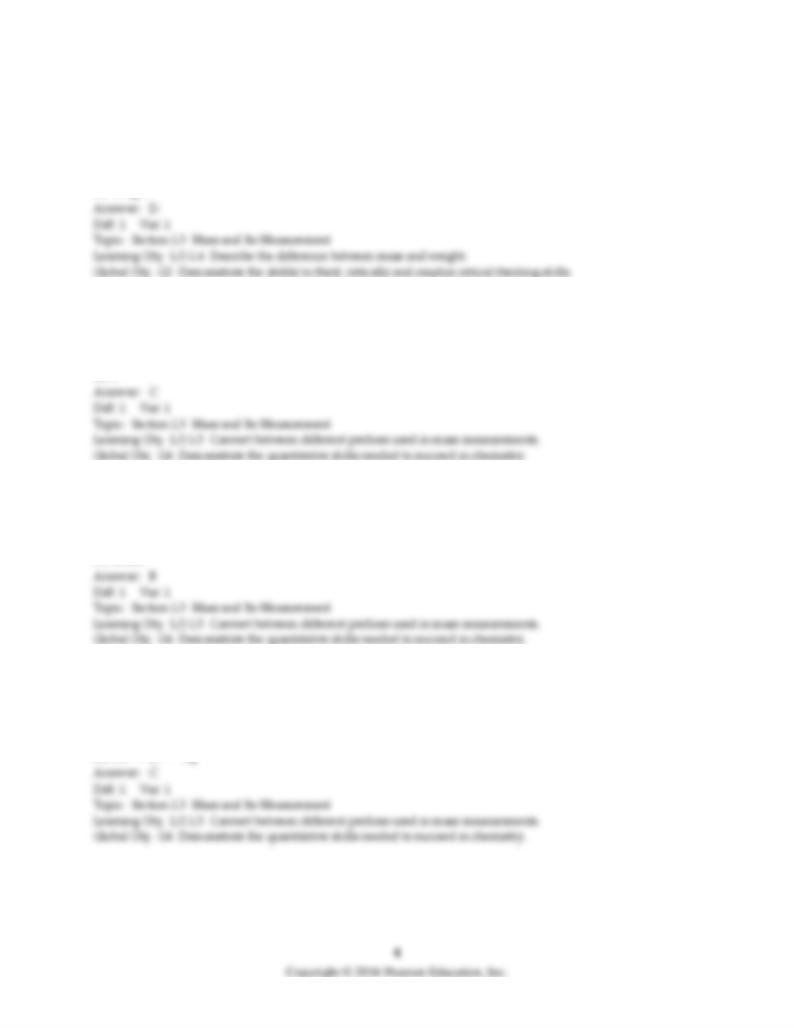
12) When measuring a solid metal block at constant temperature, which measurement will change in
numerical value depending on the location where it is taken?
A) length
B) mass
C) volume
D) weight
13) One kilogram is slightly more than ________ U.S. pounds.
A) 0.5
B) 1
C) 2
D) 5
14) One gram is approximately the same as half the mass of a new U.S.
A) penny.
B) dime.
C) quarter.
D) dollar.
15) The mass of a proton is 1.67 × 10-27 kg. What is the mass of a proton in Gigagrams?
A) 1.67 × 10-39 Gg
B) 1.67 × 10-36 Gg
C) 1.67 × 10-33 Gg
D) 1.67 × 10-30 Gg
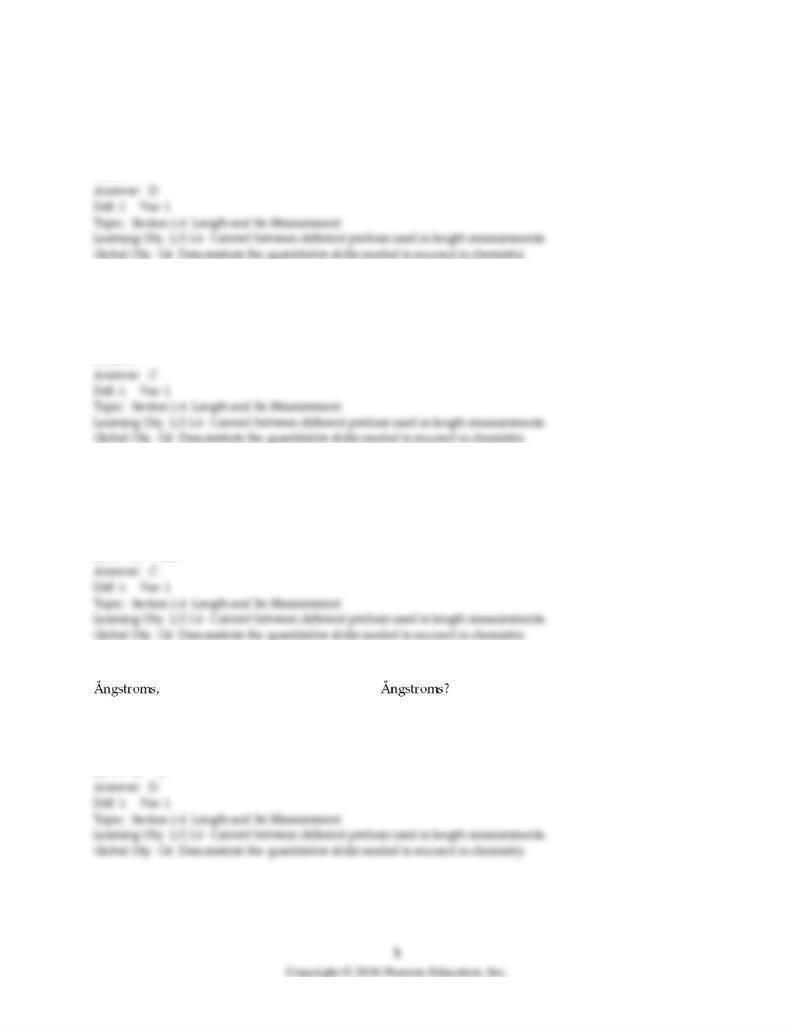
16) The number of cm in 1.0 in is closest to
A) 1.0.
B) 1.5.
C) 2.0.
D) 2.5.
17) The thickness of a U.S. dime is approximately one
A) m.
B) cm.
C) mm.
D) μm.
18) The diameter of an atom is approximately 1 × 10-10 m. What is the diameter in millimeters?
A) 1 × 10-16 mm
B) 1 × 10-13 mm
C) 1 × 10-7 mm
D) 1 × 10-4 mm
19) The diameter of the nucleus of an atom is approximately 1 × 10-15 meters. If 1 nm is equal to 10
what is the diameter of the nucleus in
A) 1 × 10-23 Å
B) 1 × 10-8 Å
C) 1 × 10-7 Å
D) 1 × 10-5 Å
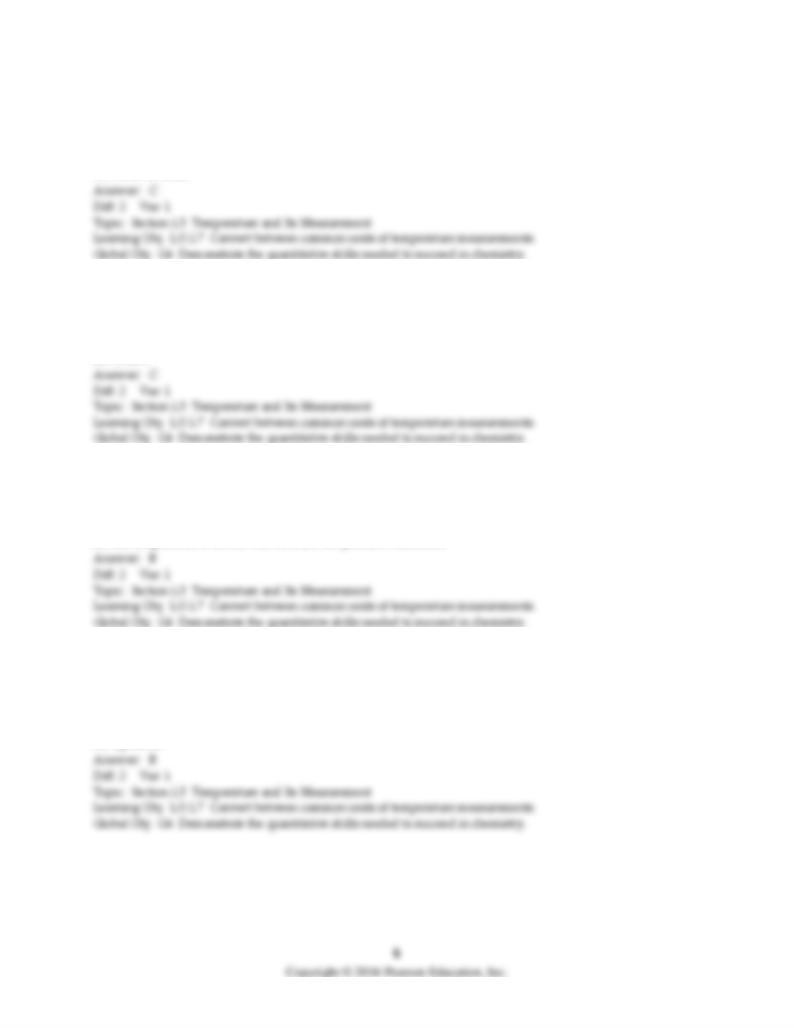
20) What is the coldest temperature possible?
A) 0°C
B) 0°F
C) 0 K
D) None of these
21) If the melting point of titanium metal is 1672°C, what is its melting point in Kelvin?
A) 897 K
B) 1399 K
C) 1945 K
D) 3042 K
22) Which one of the following statements about temperature scales is false?
A) The boiling point of water on the Fahrenheit scale is 212 degrees.
B) The Celsius degree is smaller than the Fahrenheit degree.
C) The freezing point of water on the Celsius scale is 0 degrees.
D) All temperatures on the Kelvin scale are positive numbers.
23) The freezing point of methane is -295°F and the boiling point is -263°F. The temperature of the surface
of Titan, a moon of Saturn, is 93 K. If methane exists on Titan, it is
A) a gas.
B) a liquid.
C) a solid.
D) a plasma.
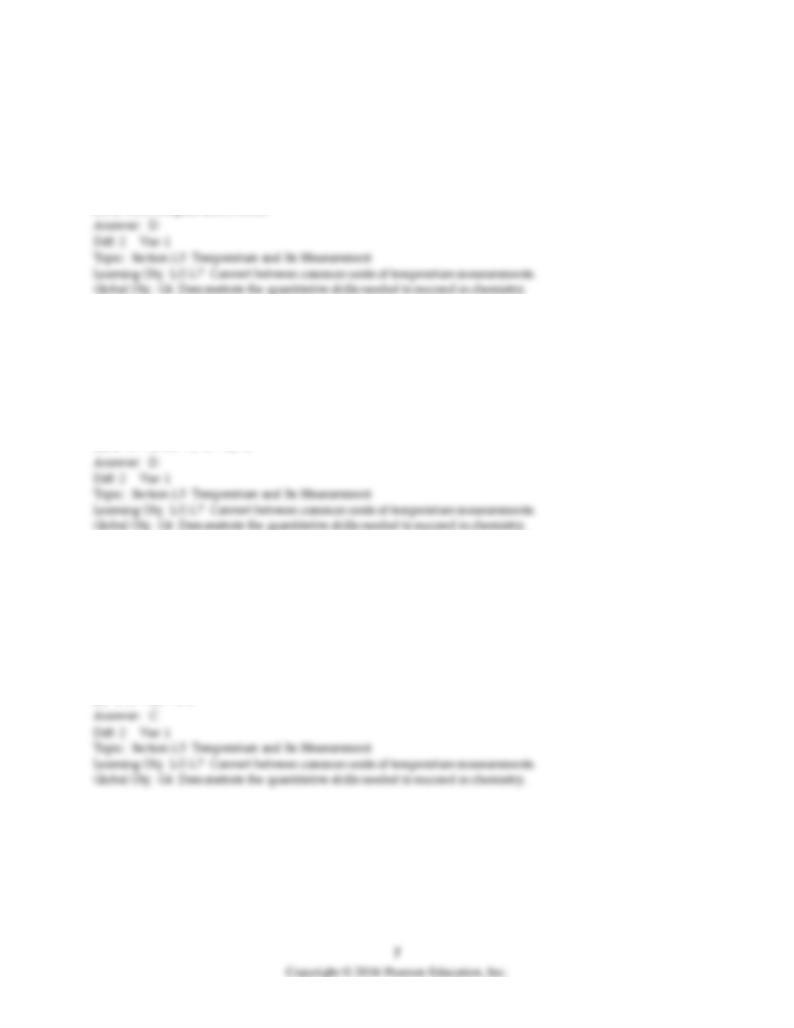
24) The nighttime and daytime temperatures on Mercury are 13 K and 683 K respectively. The melting
point and boiling point of sulfur is 246°F and 832°F. Which of the following statements is true? On
Mercury sulfur exists
A) only in the liquid state.
B) only in the solid state.
C) as both a liquid and a gas.
D) as both a liquid and a solid.
25) Which of the following correctly ranks the following temperatures from smallest to largest?
23°C, 17°F, 273K, 1°C
A) 23°C < 17°F < 273K < 1°C
B) 1°C < 17°F < 23°C < 273K
C) 273K < 23°C < 1°C < 17°F
D) 17°F < 273K < 1°C < 23°C
26) The temperature scales of Kelvin, Celsius, and Fahrenheit use different ways to define scale. Which of
the following correctly ranks the temperature from smallest to largest?
0°C, 0°F, 0K
A) 0K < 0°C < 0°F
B) 0°C < 0K < 0°F
C) 0K < 0°F < 0°C
D) 0°C = 0K = 0°F
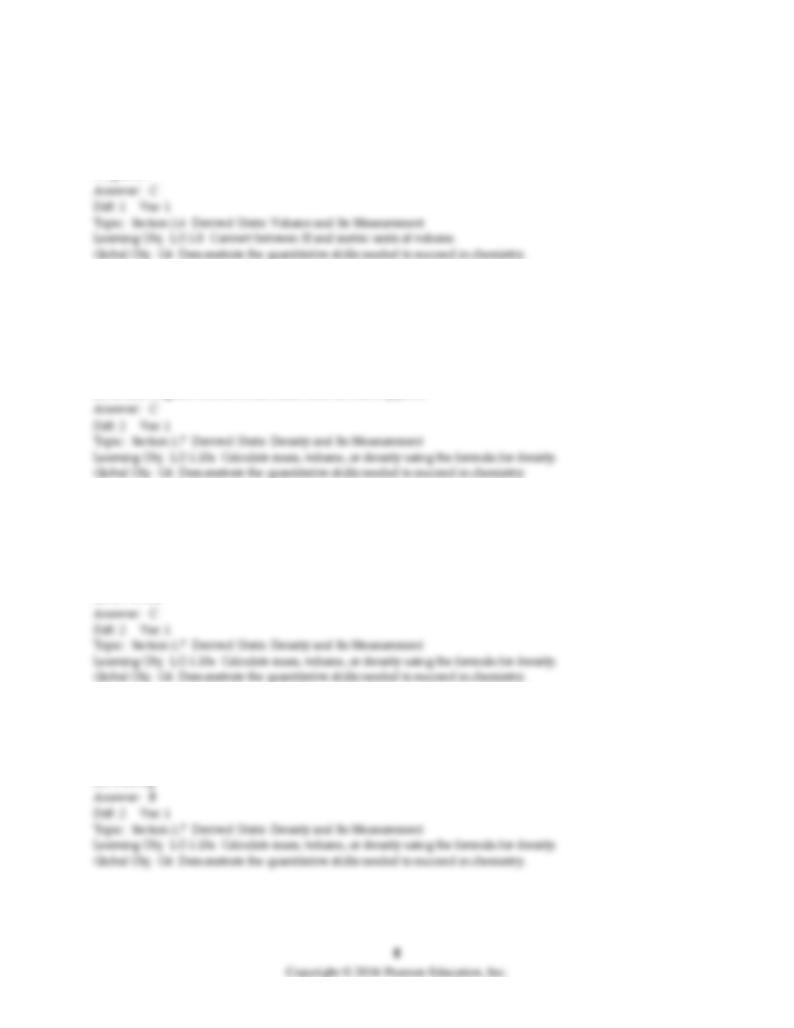
27) One liter is approximately the same as one U.S.
A) ounce.
B) pint.
C) quart.
D) gallon.
28) Pyrite is called fool's gold because it looks like real gold. However, pyrite has a density of 4.5 g/mL
while gold has a density of 19.3 g/mL. Use this information to determine which of the following
statements is true.
A) 25 grams of gold will occupy a greater volume than 25 grams of pyrite.
B) 25 grams of gold will occupy the same volume as 25 grams of pyrite.
C) 25 mL of gold will have a greater mass than 25 mL of pyrite.
D) 25 mL of gold will have less mass than 25 mL of pyrite.
29) The density of aluminum is 2.702 g/cm3. What is the final liquid level of water if 1.130 ounces of
aluminum is dropped into a graduated cylinder containing 15.90 mL of water?
A) 17.08 mL
B) 21.66 mL
C) 27.76 mL
D) 47.95 mL
30) The density of mercury is 13.5 g/mL. What is the mass in kg of mercury that fills a 0.250 L flask?
A) 0.0540 kg
B) 3.38 kg
C) 54.0 kg
D) 3380 kg
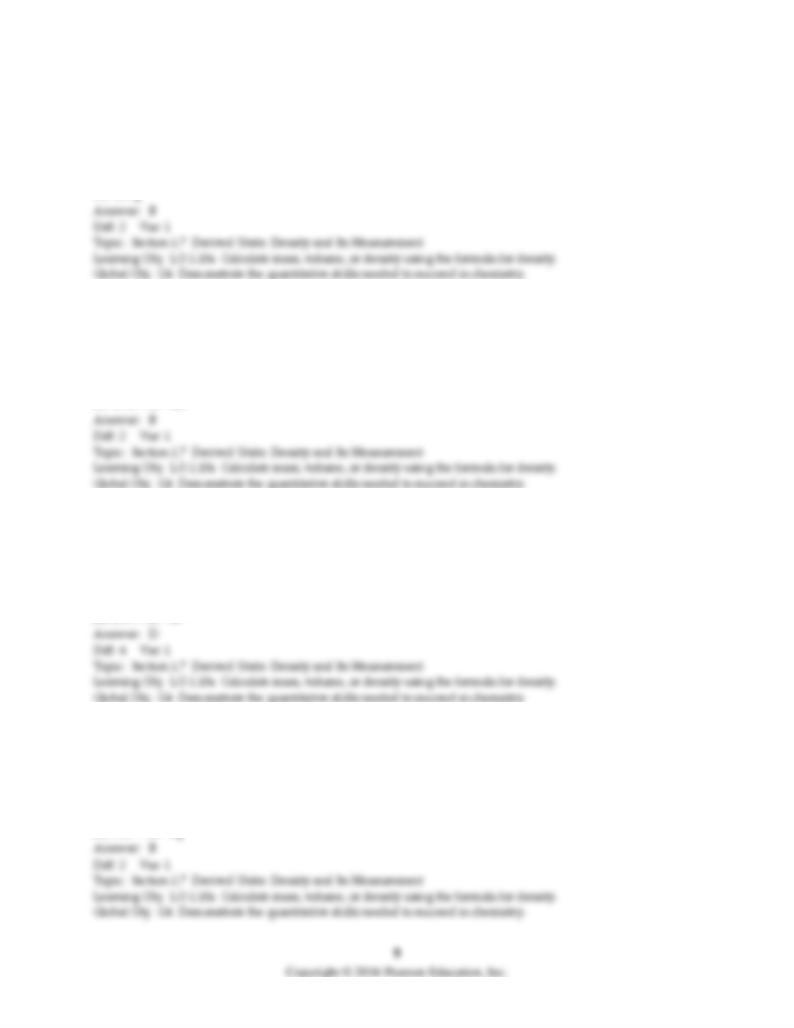
31) The density of copper is 8.96 g/cm3. What is the mass in mg of a cube of copper that measures 2.31
mm on each side?
A) 0.0207 g
B) 0.110 g
C) 2.07 g
D) 110 g
32) A gold ingot weighs 5.50 lbs. If the density of gold is 19.31 g/cm3, and the length and width of the
ingot are 12.0 cm and 3.00 cm respectively, what is the height of the ingot?
A) 6.50 × 10-3 cm
B) 3.59 cm
C) 10.2 cm
D) 1.34 × 103 cm
33) The estimated mass of the planet Jupiter is 1.90 × 1027 kg and the density is believed to be 1.34 g/cm3.
If Jupiter were a perfect sphere, what would be its diameter?
A) 6.96 × 106 m
B) 6.96 × 107 m
C) 1.39 × 107 m
D) 1.39 × 108 m
34) The volume of a well is 40.0 ft3. How many kilograms of concrete will it take to fill the well if the
density of concrete is 2.85 g/cm3?
A) 3.47 kg
B) 3.23 × 103 kg
C) 3.47 × 103 kg
D) 3.23 × 106 kg
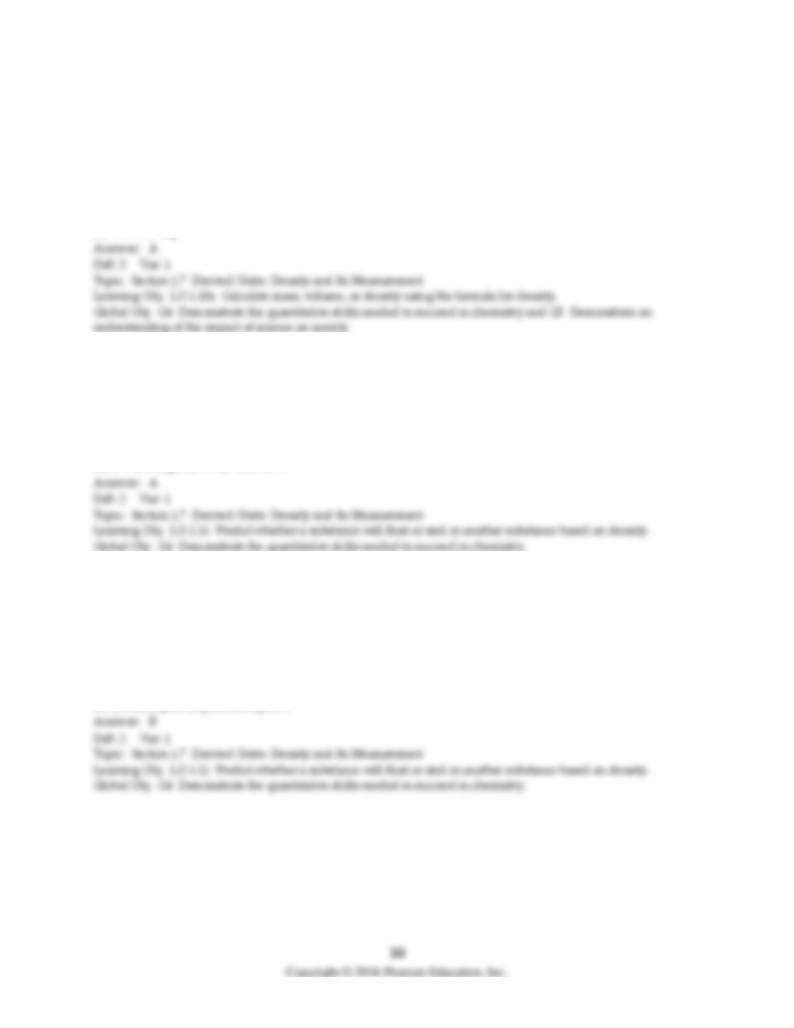
35) Because of the high heat and low humidity in the summer in Death Valley, California, a visitor
requires about one quart of water for every two miles traveled on foot. If the density of water is 0.990
g/mL at 45°C, how many kilograms of water are required for a person to walk 30 kilometers in Death
Valley?
A) 8.7 kg
B) 70 kg
C) 3.5 × 102 kg
D) 7.0 × 102 kg
36) Specific gravity of a liquid is often defined as the ratio of the density of a substance to the density of
water. If the specific gravity of X relative to water is 0.800 and the specific gravity of Y relative to water is
1.50, which of the following statements is false?
A) If X is a liquid, Y will float on X.
B) If X is a solid, X will float in water.
C) If Y is a liquid, water will float on Y.
D) If Y is a liquid, X will float in Y.
37) A piece of plastic weighing 1.157 g has a volume of 1.48 cm3. A piece of wood has the same volume
but weighs 3.85 g. The density of liquid X is 0.765 g/mL and the density of liquid Z is 1.13 g/mL. The two
liquids are immiscible. If the plastic and wood are added to the two liquids, what is the order of layers
from top to bottom in the container?
A) liquid X, liquid Z, plastic, wood
B) liquid X, plastic, liquid Z, wood
C) plastic, wood, liquid Z, liquid X
D) wood, liquid Z, plastic, liquid X
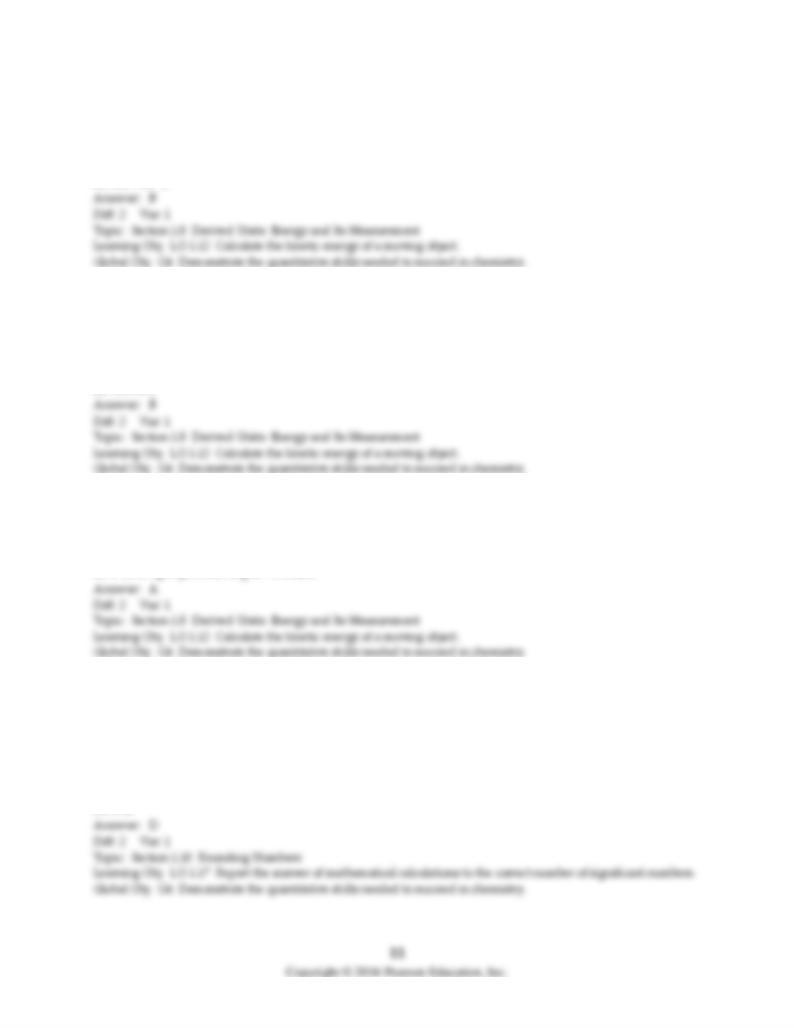
38) Calculate the kinetic energy of a 150-g baseball moving at a speed of 40. m/s (89 mph).
A) 6.0 J
B) 1.2 × 102 J
C) 6.0 × 103 J
D) 1.2 × 105 J
39) The average mass of an oxygen atom is 5.3 × 10-26 kg. Calculate the kinetic energy of a mole of
oxygen atoms, all moving at a speed of 400 m/s (1000 mph).
A) 8.2 × 10-21 J
B) 2600 J
C) 5200 J
D) 13,000 J
40) Which has the least kinetic energy?
A) a 1200 kg object moving at 90 km/hr
B) a 1400 kg object moving at 85 km/hr
C) a 1600 kg object moving at 80 km/hr
D) a 1800 kg object moving at 75 km/hr
41) How many significant figures are there in the answer to the following problem?
(8.881 × 2.100) + 0.590 = ?
A) one
B) two
C) three
D) four
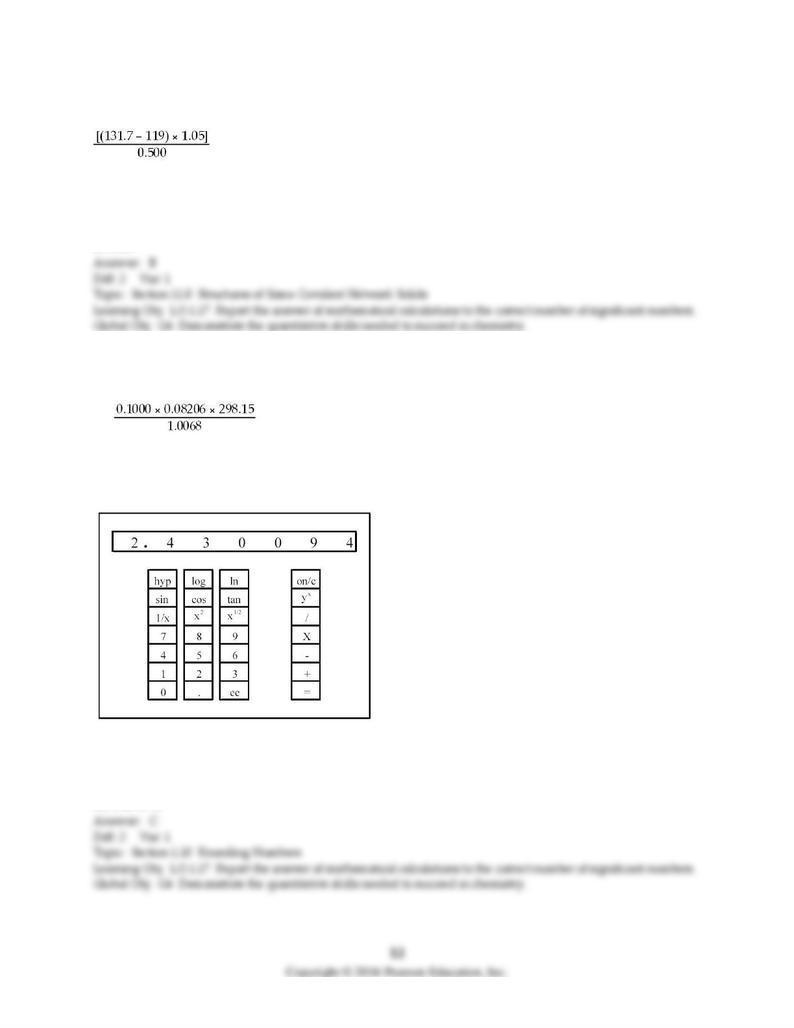
42) How many significant figures are there in the answer for the following problem?
= ?
A) one
B) two
C) three
D) four
43) Each of the numbers in the following calculation represents a quantity measured by a student in the
laboratory.
P =
After performing the calculation, the student's calculator appeared as shown below:
To the correct number of significant figures what is the value of P?
A) 2
B) 2.43
C) 2.430
D) 2.430094
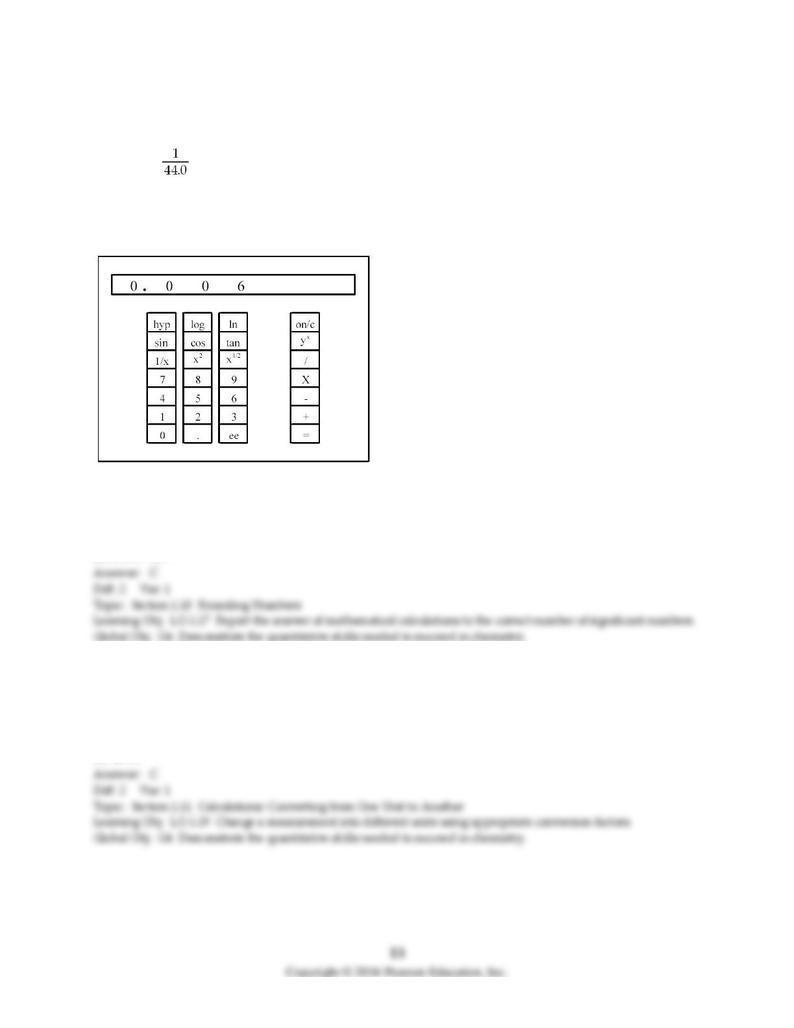
44) Each of the numbers in the following calculation represents a quantity measured by a student in the
laboratory.
g = 0.0220 × × 12.0
After performing the calculation, the student's calculator appeared as shown below:
To the correct number of significant figures what is the value of g?
A) 6 × 10-3
B) 6.0 × 10-3
C) 6.00 × 10-3
D) 6.000 × 10-3
45) To the correct number of significant figures, an automobile traveling at 28 mi/h is traveling at
________ km/h (1 km = 0.6214 mi).
A) 17
B) 17.40
C) 45
D) 45.06
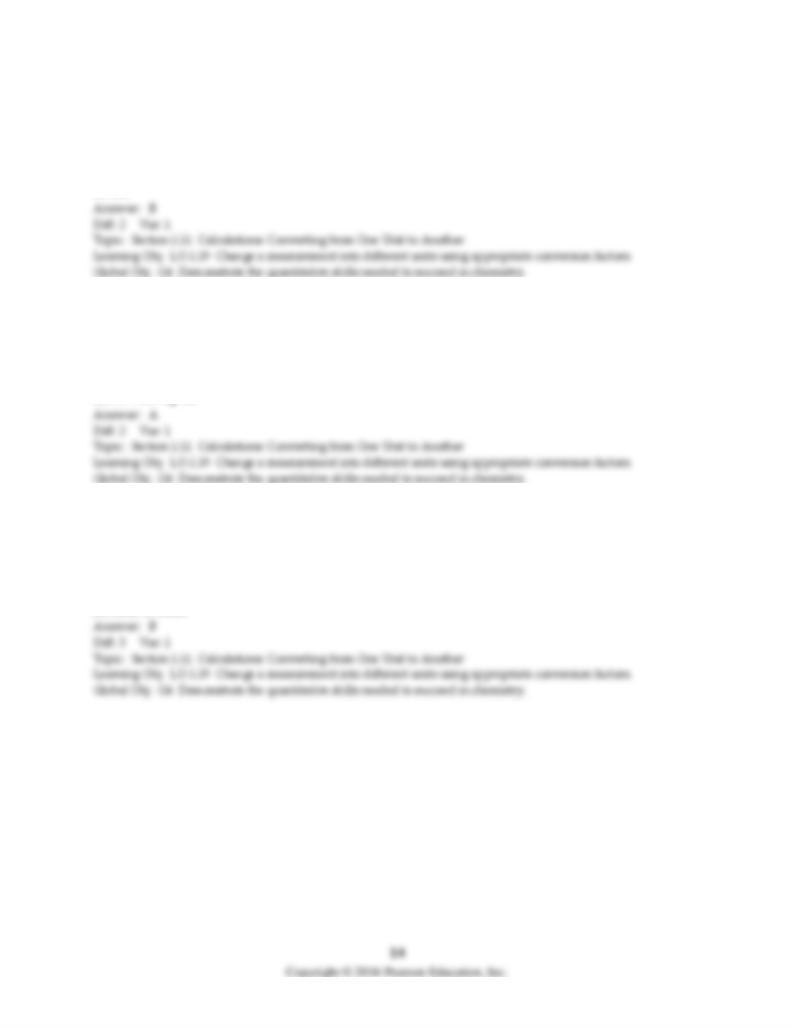
46) An automobile uses gasoline at a rate of 35 mi/gal, which is the same as ________ km/L (1 km = 0.6214
mi, 1 gal = 3.78 L).
A) 5.8
B) 15
C) 82
D) 210
47) If 1.4% of the mass of a human body is calcium, how many kilograms of calcium are there in a 173-
pound man?
A) 1.1 kg Ca
B) 5.3 kg Ca
C) 1.1 × 102 kg Ca
D) 5.3 × 102 kg Ca
48) A fishing boat accidentally spills 15 barrels of diesel oil into the ocean. Each barrel contains 42 gallons.
If the oil film on the ocean is 2.5 × 102 nm thick, how many square meters will the oil slick cover?
A) 9.5 × 10-3 m2
B) 9.5 × 106 m2
C) 9.5 × 107 m2
D) none of these
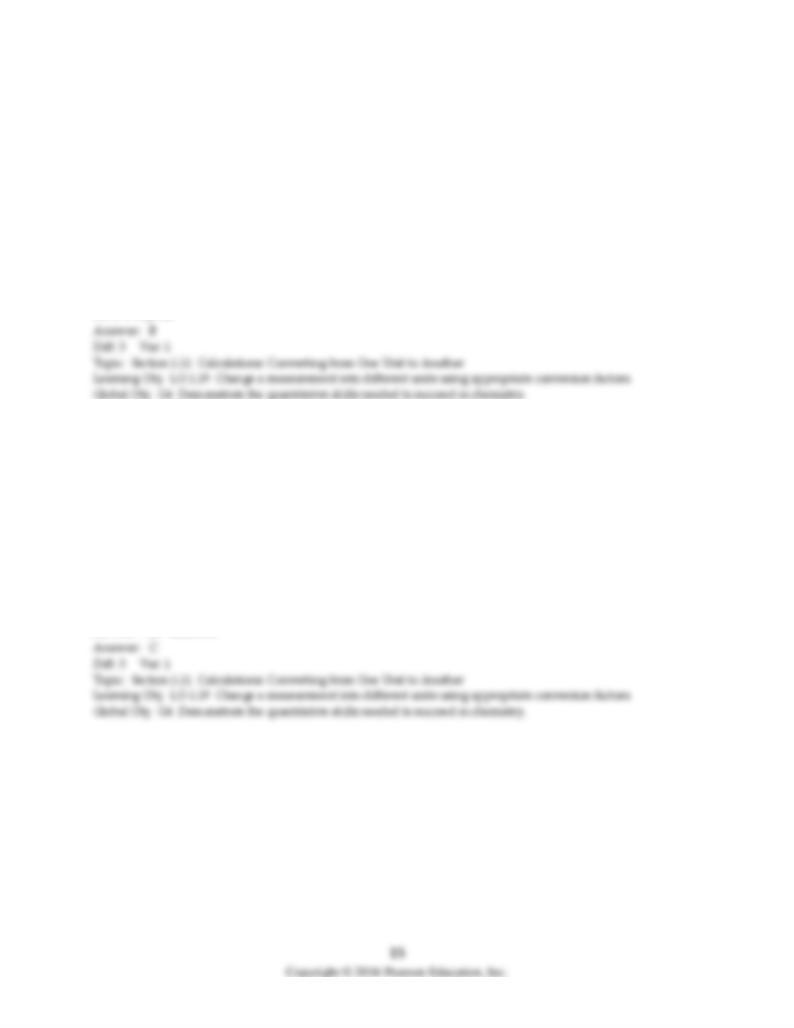
49) An international group of zookeepers with successful breeding programs made the following animal
exchanges last year. Using the same bartering system, how many oryxes can a zoo obtain in exchange for
15 flamingos?
3 oryxes = 1 tiger 2 flamingos = 1 anteater
1 camel = 6 anteaters 5 lemurs = 1 rhino
1 rhino = 4 monkeys 3 lemurs = 1 camel
3 monkeys = 1 tiger 1 rhino = 4 oryxes
A) one oryx
B) three oryxes
C) four oryxes
D) five oryxes
50) You are visiting the planet Lagmom. The money exchange rates are shown below. How many
Lagmom fizzbarts will you receive in exchange for $500 at the Lagmom Spaceport Currency Exchange
counter?
$1.00 = 10 razz 1 morb = 25 pobs
5 pobs = 1 fizzbart 5 razz = 1 tanta
1 tanta = 2 morbs
A) 5.00 × 102 fizzbarts
B) 1.00 × 103 fizzbarts
C) 1.00 × 104 fizzbarts
D) 5.00 × 105 fizzbarts
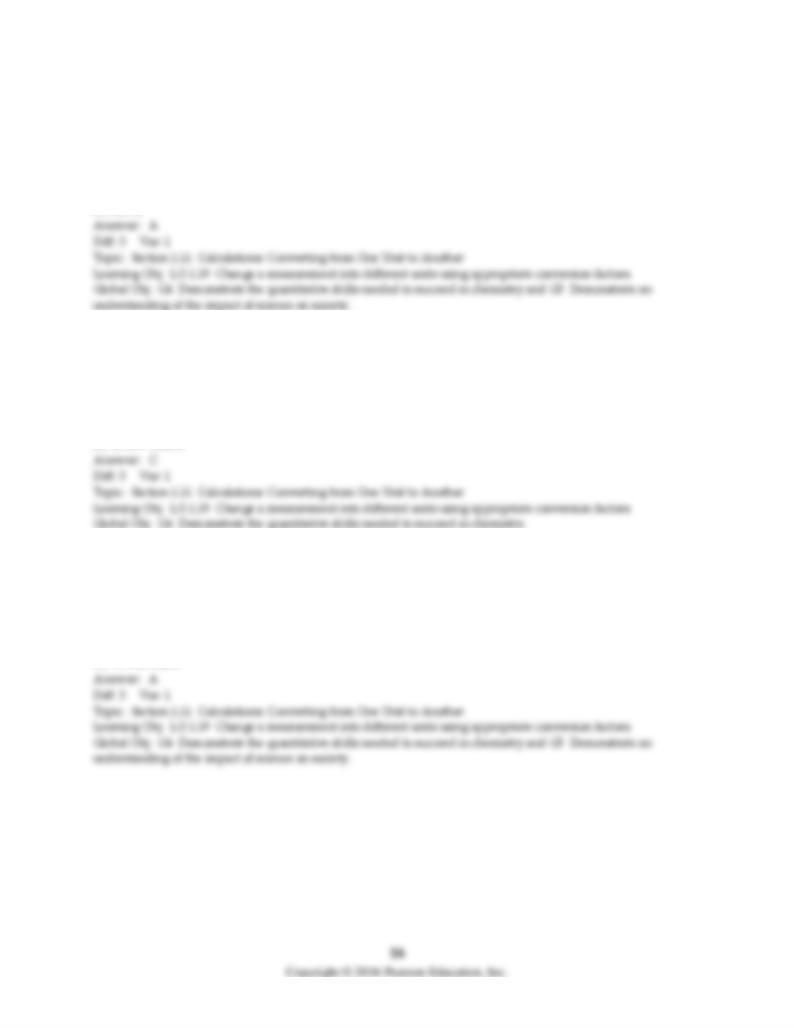
51) Because of the high heat and low humidity in the summer in Death Valley, California, a visitor
requires about one quart of water for every two miles traveled on foot. Calculate the approximate
number of liters required for a person to walk 30. kilometers in Death Valley.
A) 8.8 L
B) 35 L
C) 91 L
D) 140 L
52) A college runner set a school record of 3:59.37 in the mile run. Assuming that the distance was
measured accurately to five significant figures, what was the runner's average speed in kilometers per
hour?
A) 9.3454 km/hr
B) 10.375 km/hr
C) 24.203 km/hr
D) 26.869 km/hr
53) The winner of the men's 1500-meter speed skating event at a recent Winter Olympics had a time of
1:45.57. Assuming that the distance was measured accurately to five significant figures, what was the
skater's average speed in miles per hour?
A) 31.790 mi/hr
B) 38.418 mi/hr
C) 51.151 mi/hr
D) 61.826 mi/hr
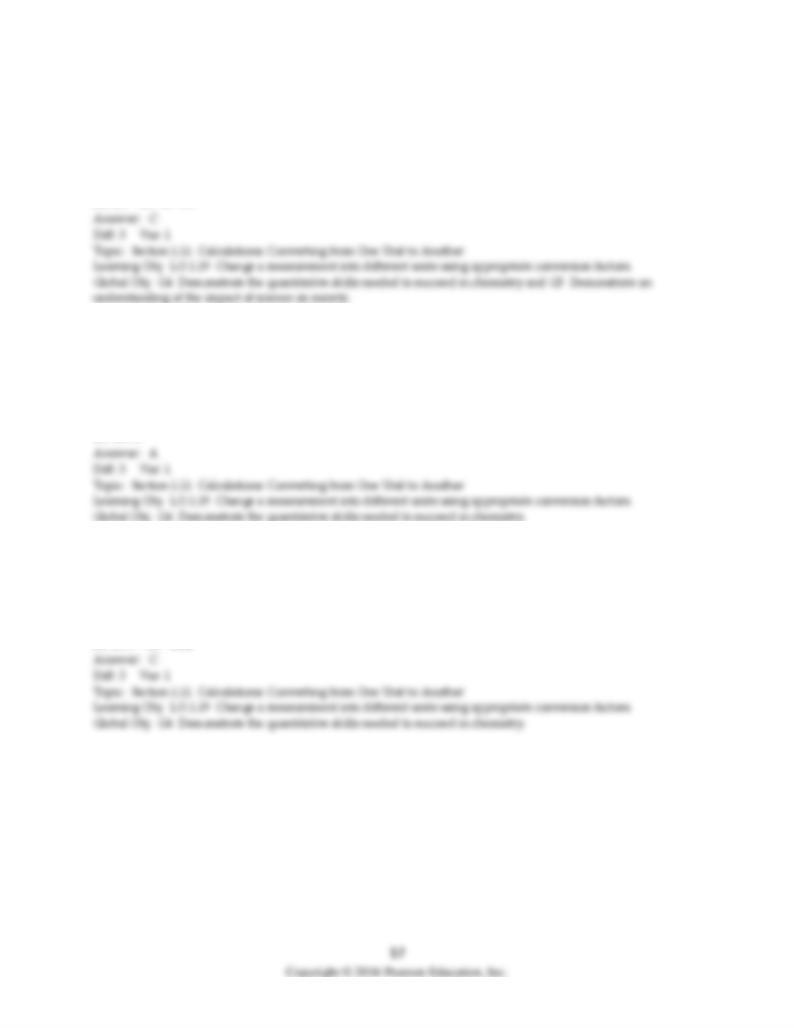
54) A motorcycle emits 9.5 g of carbon monoxide per kilometer driven. How many pounds of carbon
monoxide does the motorcycle generate over 5.0 years if the motorcycle is driven 15,000 miles per year?
A) 8.9 × 101 lb CO
B) 9.8 × 102 lb CO
C) 2.5 × 103 lb CO
D) 2.3 × 104 lb CO
55) The temperature of 1.00 mL of water is raised by 1.00°C for every 4.184 joules of heat absorbed by the
water. How many liters of water can be raised from 21.0°C to 100.0°C by the absorption of 8.88 kcal of
heat generated by the combustion of natural gas?
A) 0.112 L
B) 2.13 L
C) 37.2 L
D) 168 L
56) Combustion of hydrogen releases 142 kJ per gram of hydrogen reacted. How many kilocalories of
energy are released by the combustion of 16.0 ounces of hydrogen?
A) 1.31 kcal
B) 19.2 kcal
C) 1.54 × 104 kcal
D) 2.69 × 105 kcal
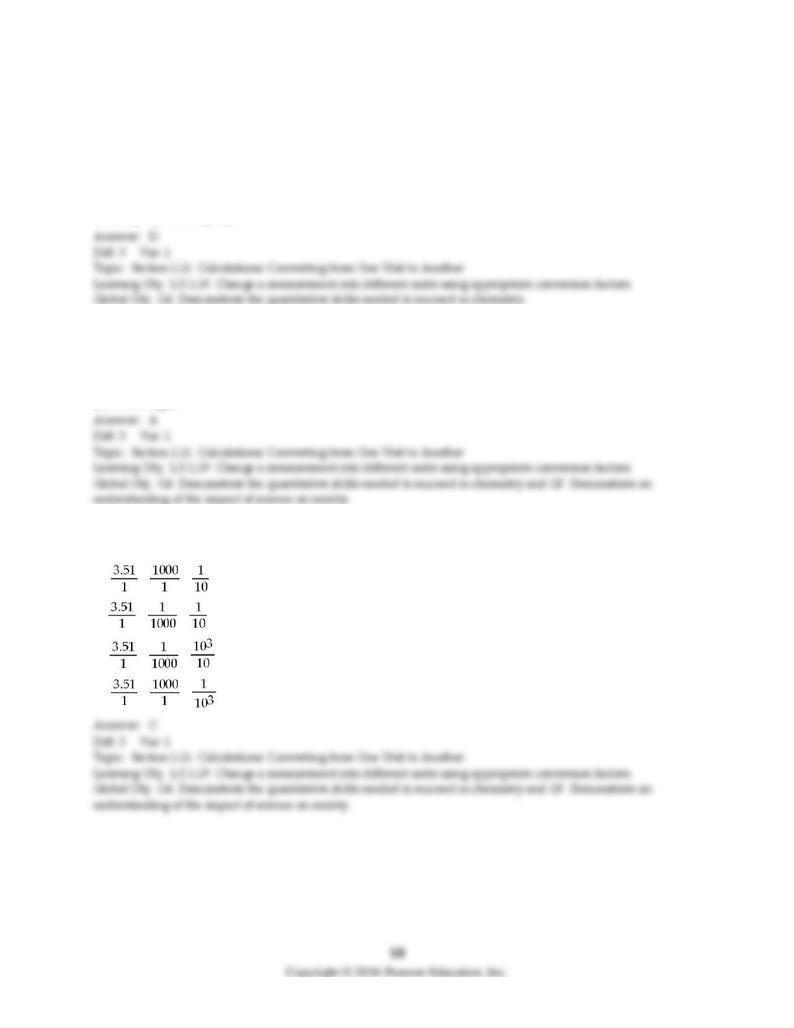
57) When 1.0 gram of hydrogen reacts with 8.0 grams of oxygen 9.0 grams of water are produced and 142
kJ of heat are released. How many grams of hydrogen and how many grams of oxygen must react to
produce 250 kJ of heat?
A) 0.57 g H2 and 4.5 g O2
B) 0.57 g H2 and 14 g O2
C) 1.8 g H2 and 4.5 g O2
D) 1.8 g H2 and 14 g O2
58) A tortoise moves at a speed of 454 cm/min. How fast is the tortoise in mph?
A) 0.17 mph
B) 0.34 mph
C) 17 mph
D) 0.0017 mph
59) A pure diamond has a density of 3.52 g/cm3. Which of the following equations will allow you to
correctly calculate the density in terms of kg/dm3?
A) × ×
B) × ×
C) × ×
D) × ×
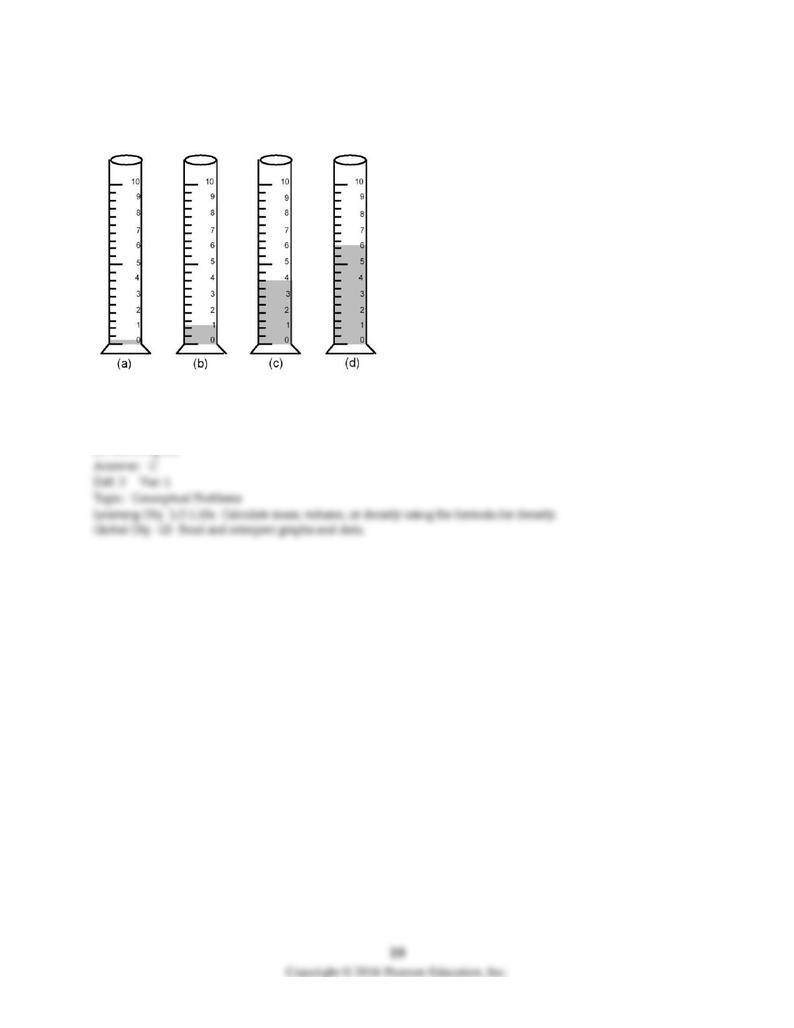
60) A certain liquid has a density of 1.25 g/cm3. Which drawing below most closely represents the
volume of this liquid needed to obtain 5.00 g of the liquid?
A) drawing (a)
B) drawing (b)
C) drawing (c)
D) drawing (d)
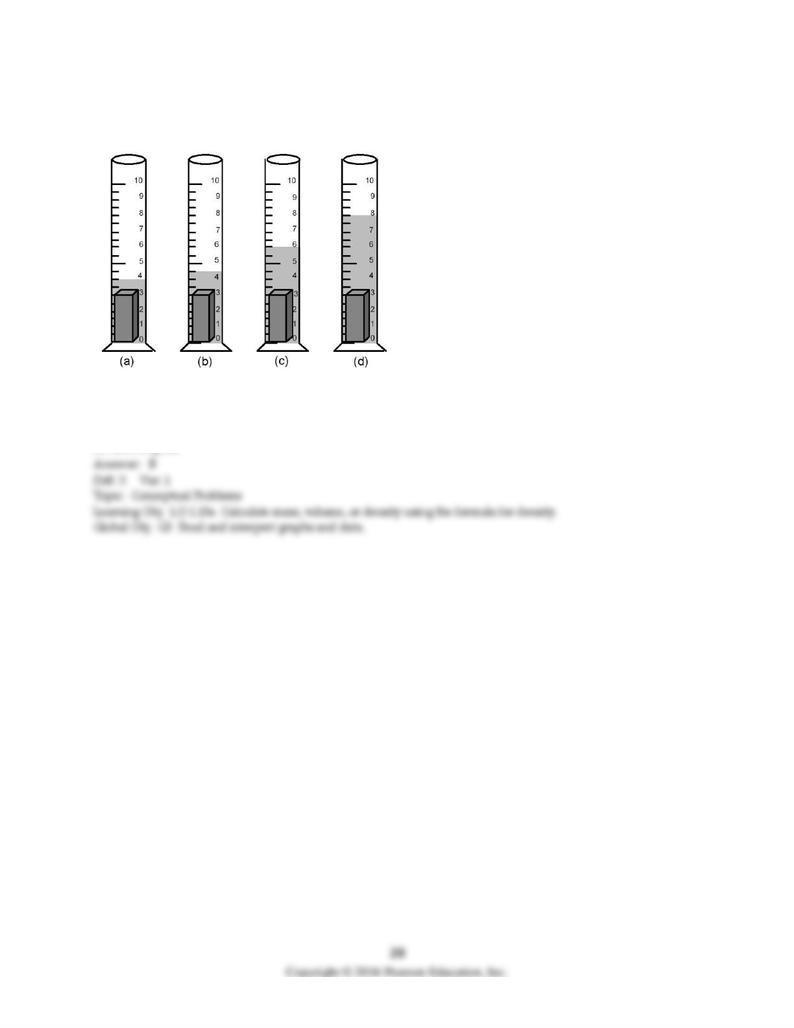
61) A certain solid has a density of 8.0 g/cm3. If 4.0 g of this solid are poured into 4.00 mL of water, which
drawing below most closely represents the volume of water after the solid is added?
A) drawing (a)
B) drawing (b)
C) drawing (c)
D) drawing (d)
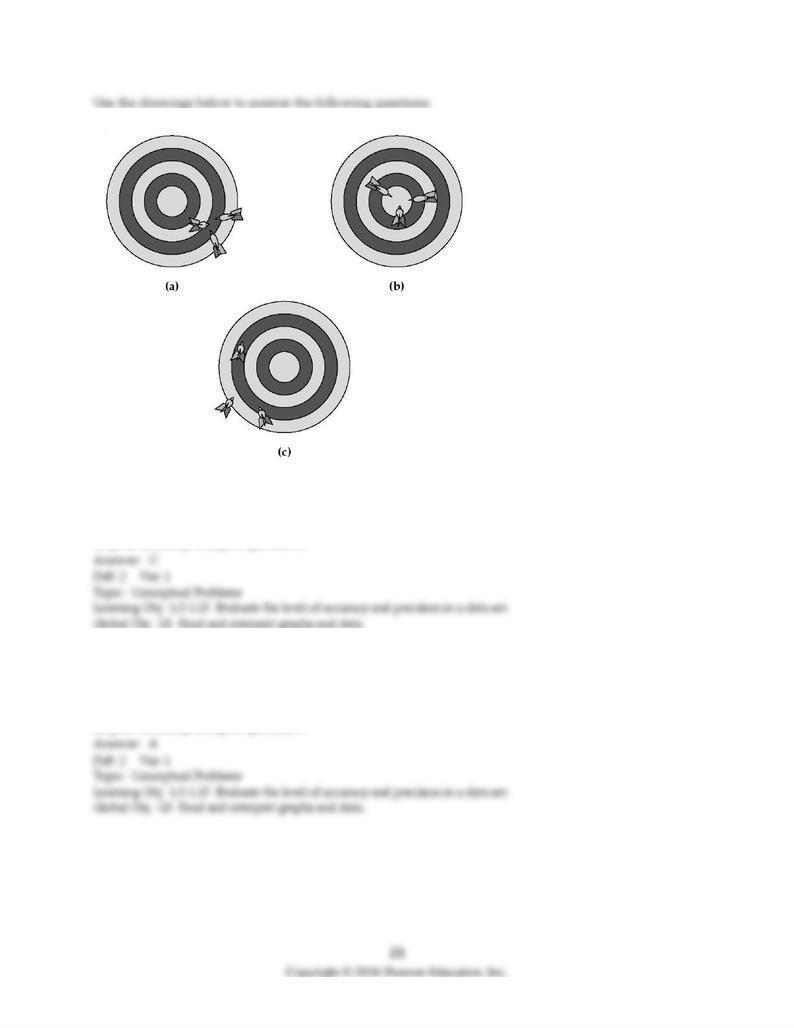
62) If hitting the bull's-eye is the desired result, Figure (a) represents
A) good accuracy and good precision.
B) good accuracy and poor precision.
C) poor accuracy and good precision.
D) poor accuracy and poor precision.
63) If hitting the bull's-eye is the desired result, Figure (b) represents
A) good accuracy and good precision.
B) good accuracy and poor precision.
C) poor accuracy and good precision.
D) poor accuracy and poor precision.
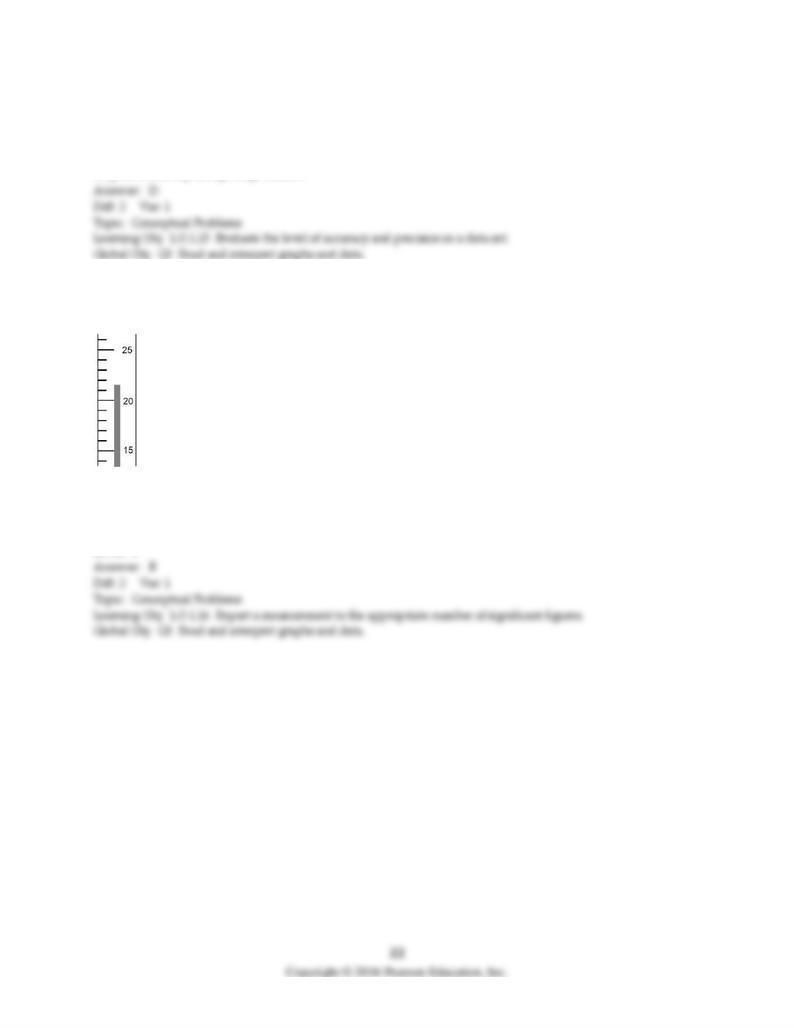
64) If hitting the bull's-eye is the desired result, Figure (c) represents
A) good accuracy and good precision.
B) good accuracy and poor precision.
C) poor accuracy and good precision.
D) poor accuracy and poor precision.
65) To the correct number of significant figures, what is the temperature reading on the following Celsius
thermometer?
A) 21°C
B) 21.7°C
C) 21.70°C
D) 22°C
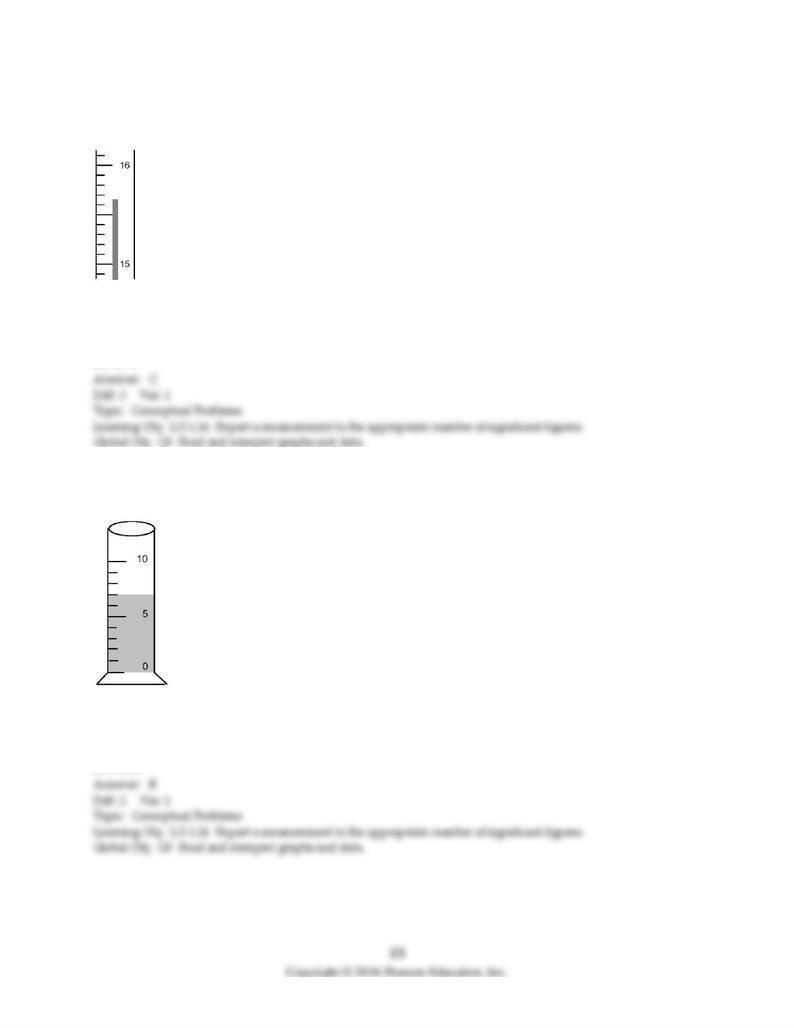
66) To the correct number of significant figures, what is the temperature reading on the following Celsius
thermometer?
A) 15°C
B) 15.6°C
C) 15.67°C
D) 16°C
67) To the correct number of significant figures, what is the volume of the liquid in the graduated
cylinder?
A) 7 mL
B) 7.0 mL
C) 7.7 mL
D) 8 mL
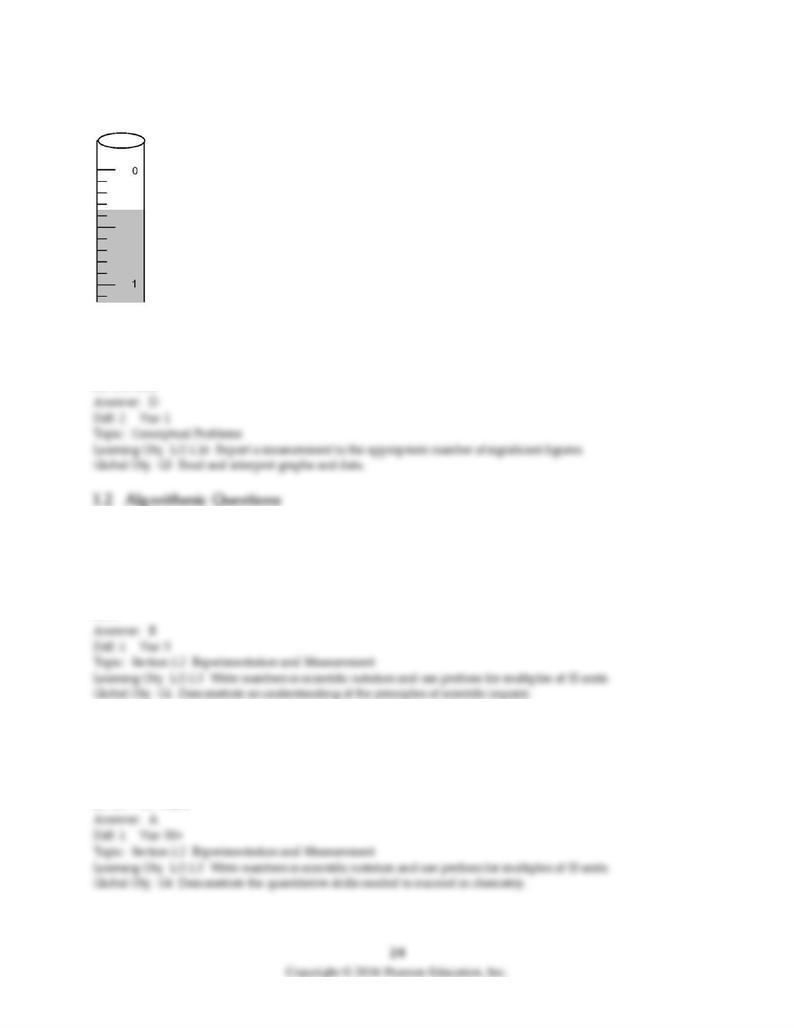
68) To the correct number of significant figures, what is the level of the liquid in the buret?
A) 0.2 mL
B) 0.29 mL
C) 0.3 mL
D) 0.35 mL
1) What symbol is used to represent the factor 10-2?
A) M
B) c
C) μ
D) n
2) Which of the following is the smallest unit?
A) 13 centi
B) 3.0 deci
C) 3.3 × 103 milli
D) 1.5 × 106 nano
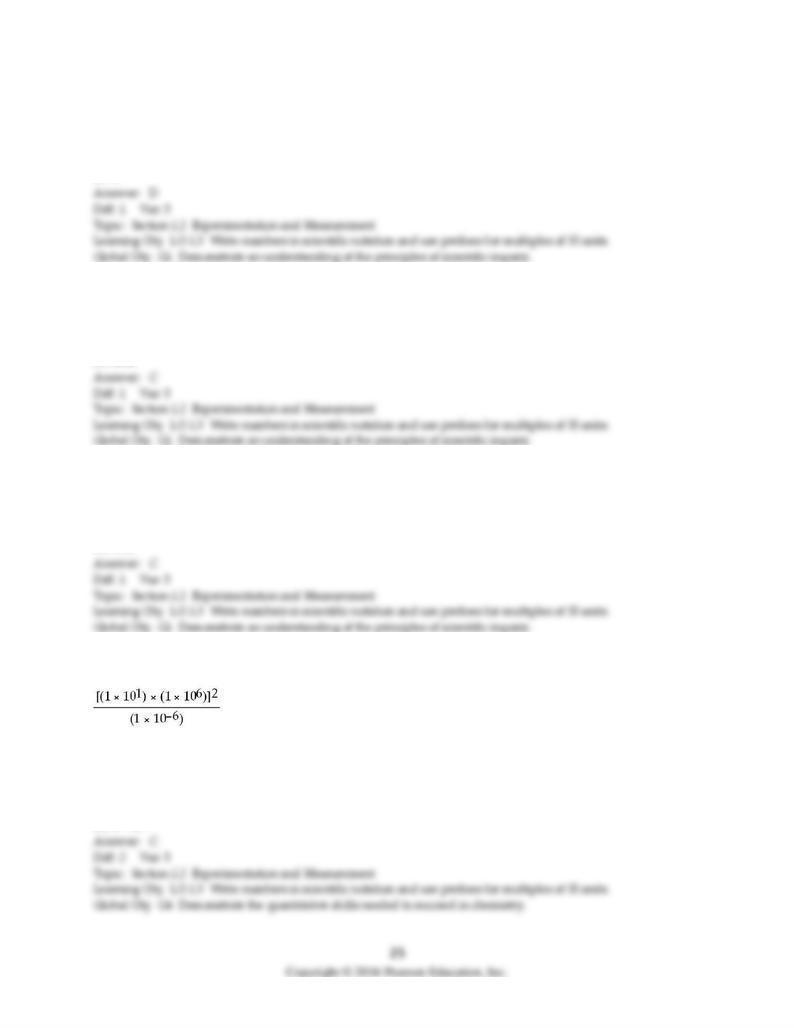
3) What symbol is used to represent the factor 109?
A) M
B) m
C) μ
D) G
4) The factor 10 corresponds to which prefix?
A) centi
B) deci
C) deka
D) milli
5) The factor 106 corresponds to which prefix?
A) deka
B) deci
C) mega
D) milli
6) Without using a calculator, solve the following problem:
A) 1 × 102
B) 1 × 108
C) 1 × 1020
D) 1 × 1026
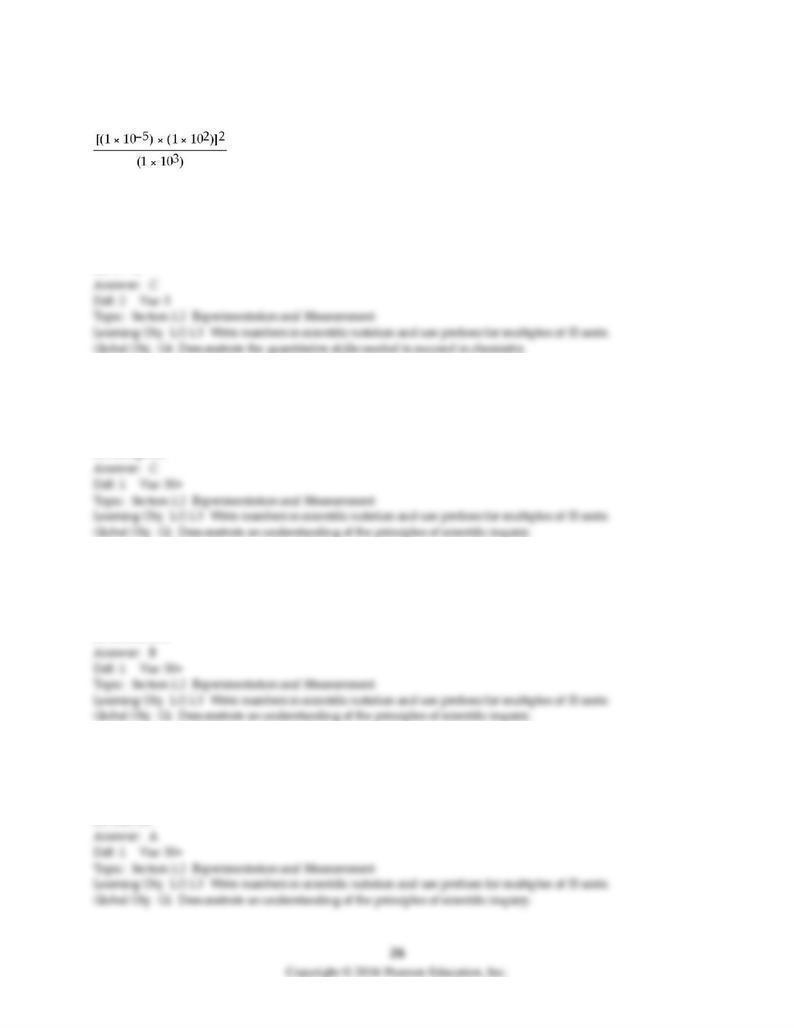
7) Without using a calculator, solve the following problem:
A) 1 × 100
B) 1 × 10-3
C) 1 × 10-9
D) 1 × 10-12
8) The fundamental SI unit of mass is the
A) gigagram.
B) microgram.
C) kilogram.
D) decigram.
9) Which of the following is a fundamental SI Unit?
A) millimeter
B) meter
C) hectometer
D) nanometer
10) All of the following are fundamental SI units except the
A) year.
B) kilogram.
C) mole.
D) Kelvin.
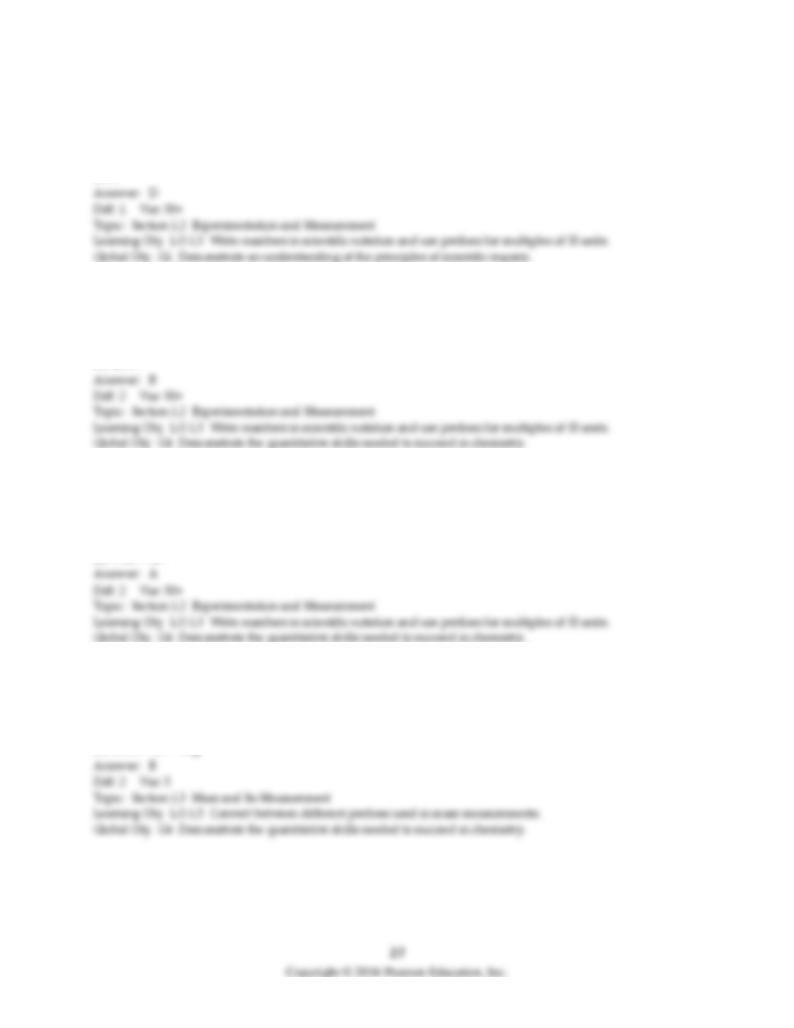
11) What symbol is used to represent the factor 10-9?
A) G
B) c
C) μ
D) n
12) Convert 4.300 × 10-3 to ordinary notation.
A) 0.0004300
B) 0.004300
C) 430.0
D) 4300
13) Convert 0.009723 to standard scientific notation.
A) 9.723 × 10-3
B) 9723 × 10-6
C) 9.723 × 103
D) 9723 × 106
14) Which of the following is the greatest mass?
A) 10,000 μg
B) 1.000 × 10-3 kg
C) 1.000 × 10-3 cg
D) 1.000 × 10-7 Mg
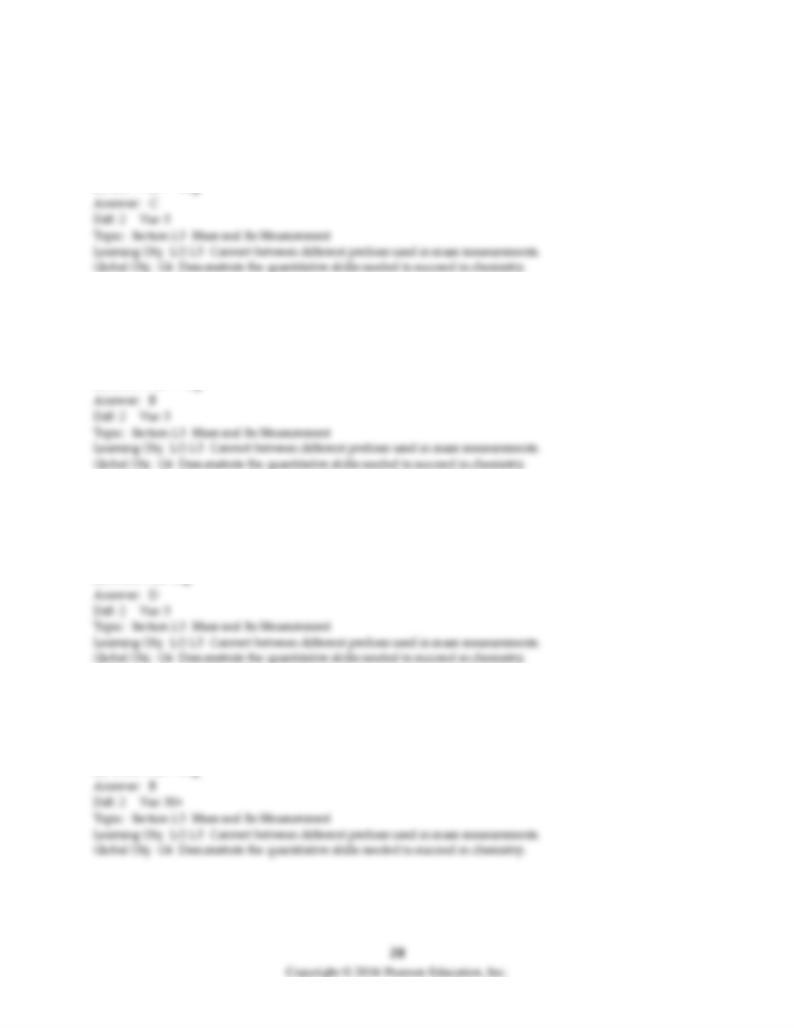
15) The mass of a proton is 1.67 × 10-27 kg. What is the mass of a proton in Megagrams?
A) 1.67 × 10-36 Mg
B) 1.67 × 10-33 Mg
C) 1.67 × 10-30 Mg
D) 1.67 × 10-27 Mg
16) The mass of a single copper atom is 1.055 × 10-22 g. This is the same mass as
A) 1.055 × 10-16 mg.
B) 1.055 × 10-25 kg.
C) 1.055 × 10-28 μg.
D) 1.055 × 10-31 ng.
17) A student weighed 3.000 μg of sulfur in the lab. This is the same mass as
A) 3.000 × 10-9 g.
B) 3.000 × 10-6 kg.
C) 3.000 × 10-6 mg.
D) 3.000 × 103 ng.
18) Which of the following is the greatest mass?
A) 10 μg
B) 1.000 × 10-4 kg
C) 1.000 × 10-2 cg
D) 1.000 × 10-8 Mg
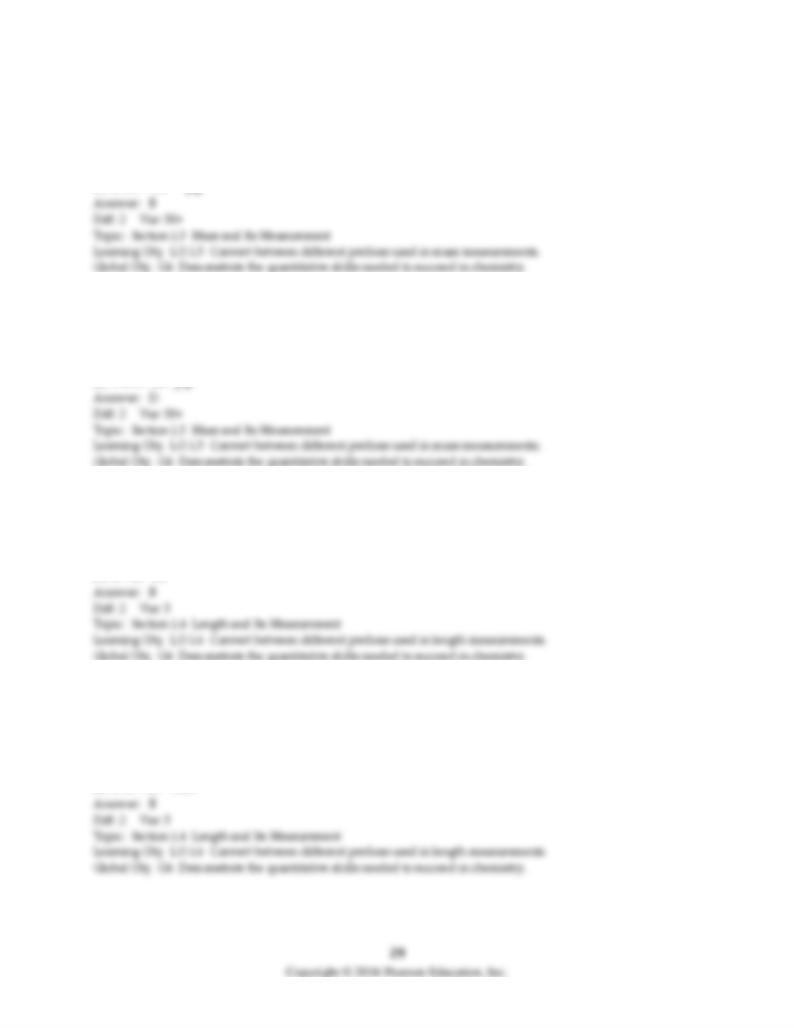
19) The mass of a single copper atom is 1.055 × 10-22 g. This is the same mass as
A) 1.055 × 10-17 dg.
B) 1.055 × 10-28 mg.
C) 1.055 × 10-28 μg.
D) 1.055 × 10-33 pg.
20) A student weighed 9000. μg of sulfur in the lab. This is the same mass as
A) 9.000 × 10-6 g.
B) 9.000 × 10-3 kg.
C) 9.000 × 102 cg.
D) 9.000 × 109 pg.
21) Convert 1 μm to meters.
A) 1 × 10-9 m
B) 1 × 10-6 m
C) 1 × 10-3 m
D) 1 × 106 m
22) The average distance between nitrogen and oxygen atoms is 115 pm in a compound called nitric
oxide. What is this distance in nanometers?
A) 1.15 × 10-2 nm
B) 1.15 × 10-1 nm
C) 1.15 × 1015 nm
D) 1.15 × 1019 nm
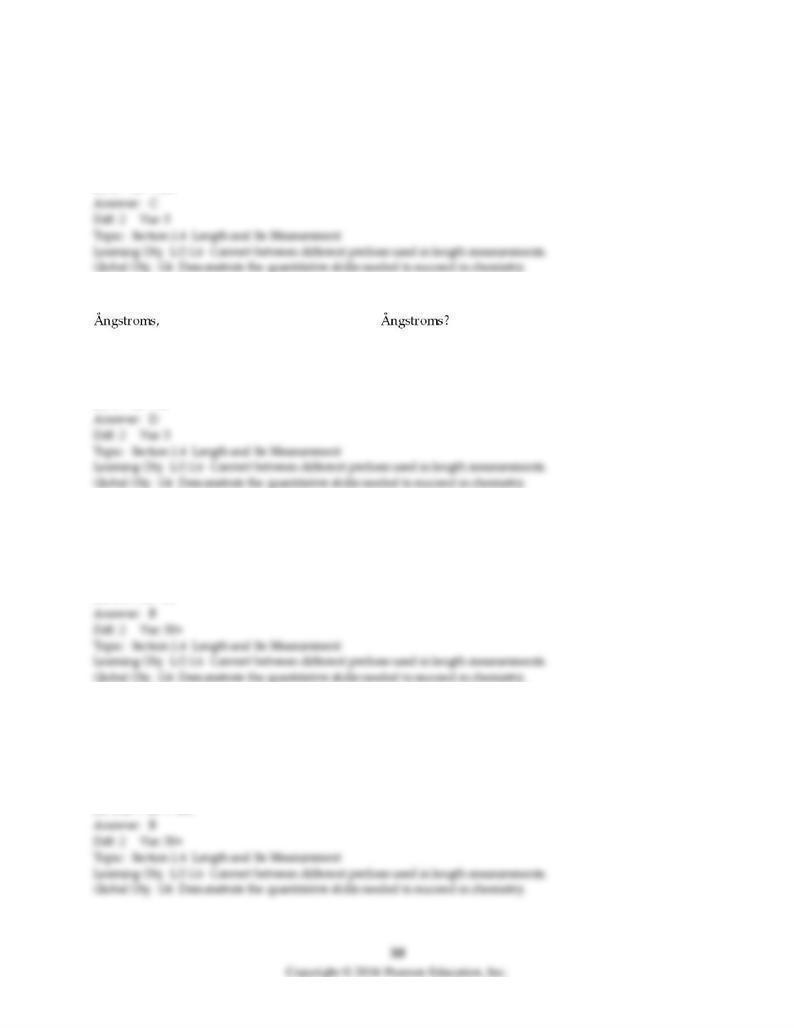
23) The diameter of an atom is approximately 1 × 10-10 m. What is the diameter in centimeters?
A) 1 × 10-13 cm
B) 1 × 10-12 cm
C) 1 × 10-8 cm
D) 1 × 10-7 cm
24) The diameter of the nucleus of an atom is approximately 1 × 10-13 cm. If 1 nm is equal to 10
what is the diameter of the nucleus in
A) 1 × 10-23 Å
B) 1 × 10-8 Å
C) 1 × 10-7 Å
D) 1 × 10-5 Å
25) Convert 5.0 μm to meters.
A) 5.0 × 10+9 m
B) 5.0 × 10-6 m
C) 5.0 × 10+3 m
D) 5.0 × 106 m
26) The average distance between nitrogen and oxygen atoms is 115 pm in a compound called nitric
oxide. What is this distance in centimeters?
A) 1.15 × 10-7 cm
B) 1.15 × 10-8 cm
C) 1.15 × 1013 cm
D) 1.15 × 1018 cm
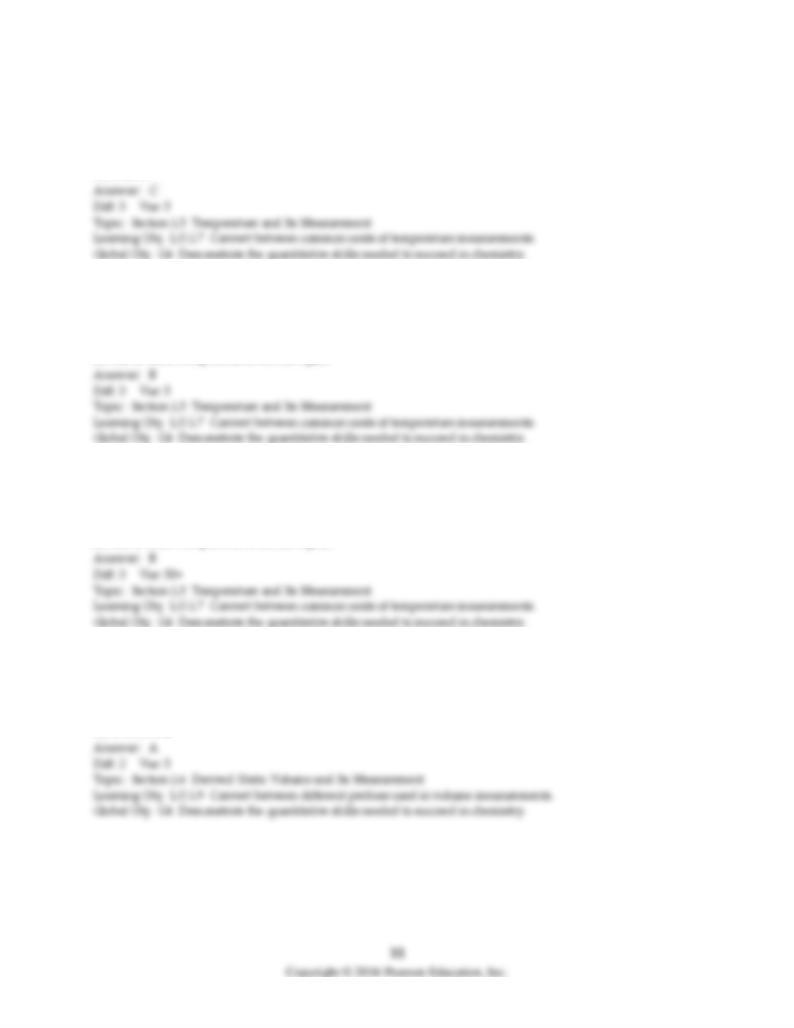
27) If the melting point of copper metal is 1085°C, what is its melting point in Kelvin?
A) 571 K
B) 812 K
C) 1358 K
D) 1985 K
28) Which of the following is the lowest temperature?
A) 37°C
B) 54°F
C) 313 K
D) All of these temperatures are all equal.
29) Which of the following is the lowest temperature?
A) 35°C
B) 57°F
C) 313 K
D) All of these temperatures are all equal.
30) Which of the following volumes is equal to 50 mL?
A) 50 cm3
B) 50 dm3
C) 0.50 L
D) 0.00050 kL
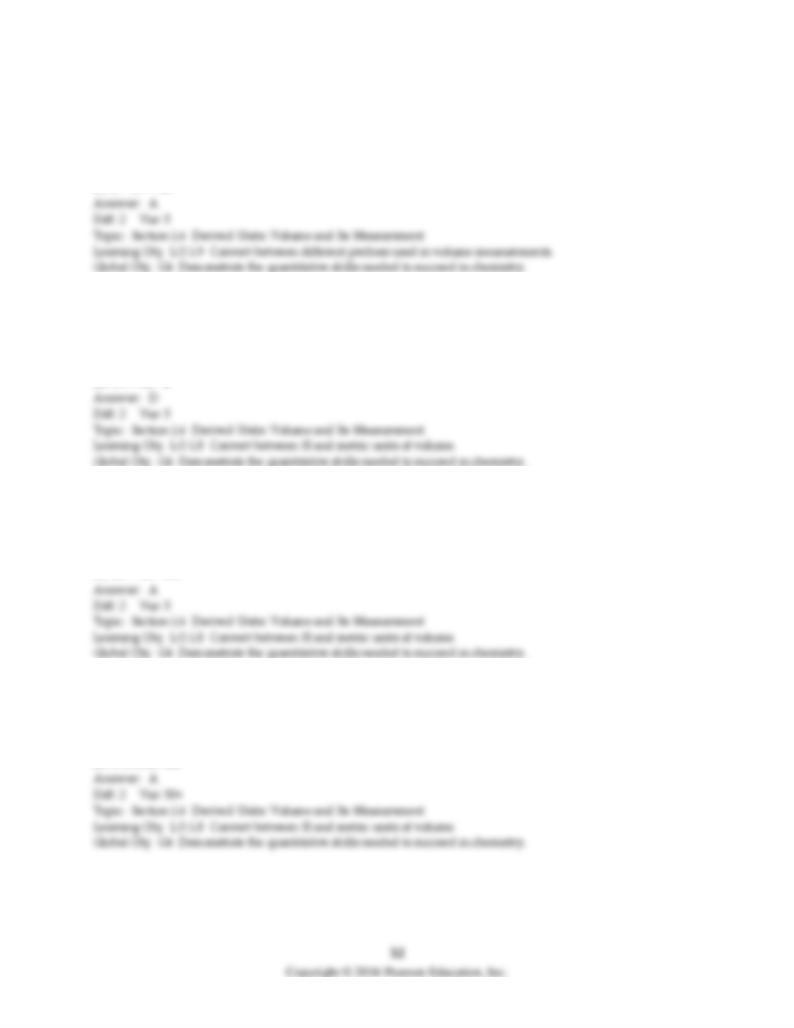
31) Convert 10,000 cm3 to m3.
A) 1 × 10-2 m3
B) 1 × 102 m3
C) 1 × 106 m3
D) 1 × 1010 m3
32) Convert 55 m3 to liters.
A) 5.5 × 10-2 L
B) 5.5 L
C) 5.5 × 102 L
D) 5.5 × 104 L
33) Which of the following is the smallest volume?
A) 11 cm3
B) 0.25 dL
C) 1.4 × 103 mL
D) 2.5 × 107 nL
34) Which of the following volumes is equal to 60.0 mL?
A) 60.0 cm3
B) 60.0 mm3
C) 0.600 L
D) 0.000600 GL
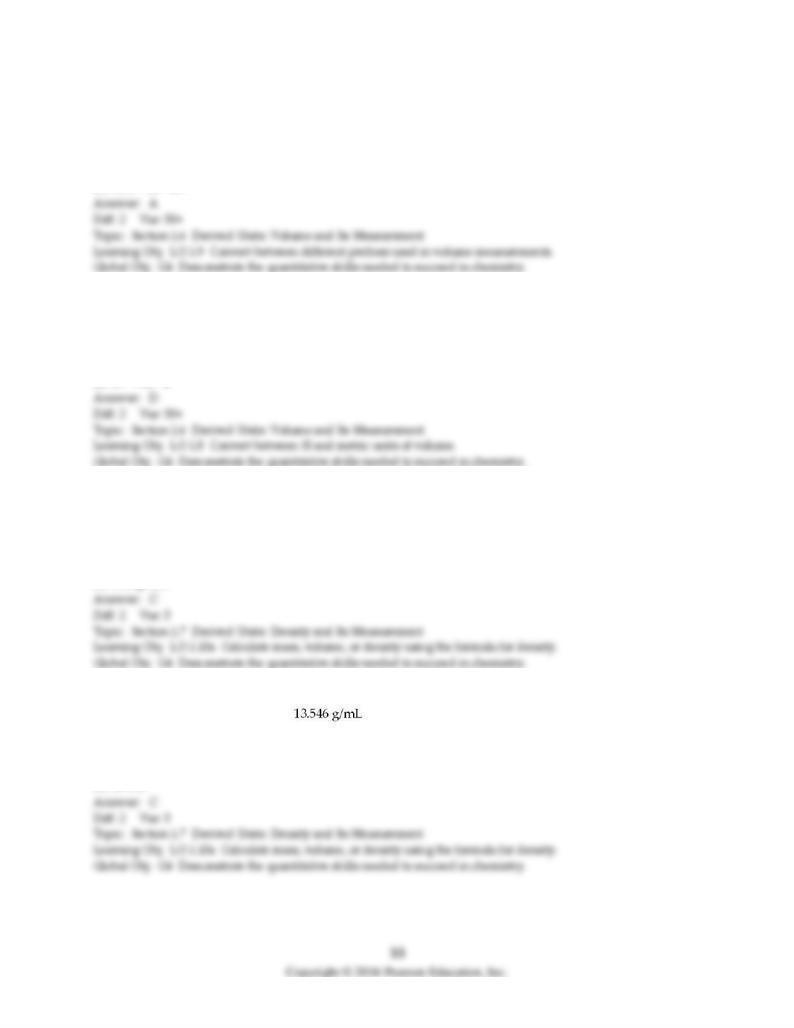
35) Convert 98.6 cm3 to m3.
A) 98.6 × 10-4 m3
B) 98.6 × 101 m3
C) 98.6 × 106 m3
D) 98.6 × 108 m3
36) Convert 17 m3 to liters.
A) 1.7 × 10-2 L
B) 1.7 L
C) 1.7 × 102 L
D) 1.7 × 104 L
37) A piece of metal ore weighs 8.50 g. When a student places it into a graduated cylinder containing
water, the liquid level rises from 21.25 mL to 26.47 mL. What is the density of the ore?
A) 0.321 g/mL
B) 0.614 g/mL
C) 1.63 g/mL
D) 3.11 g/mL
38) A mass of mercury occupies 0.950 L. What volume would an equal mass of methylene chloride
occupy? The density of mercury is and the density of methylene chloride is 1.325 g/mL.
A) 0.00929 L
B) 0.0613 L
C) 9.71 L
D) 18.1 L
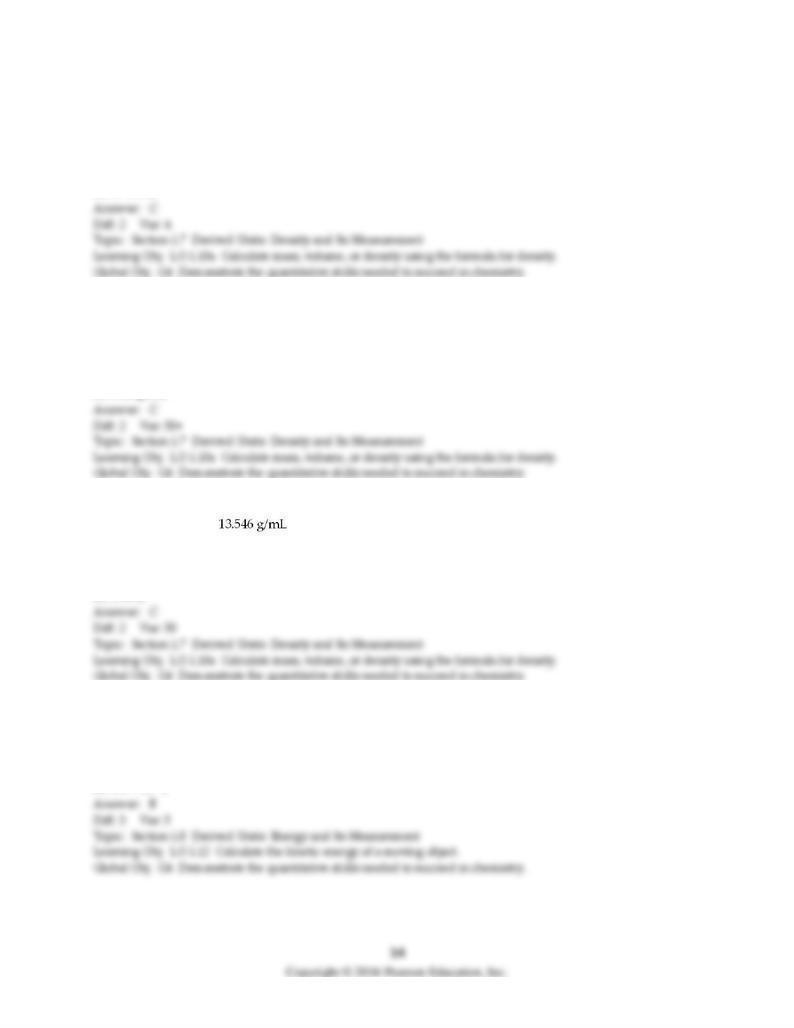
39) A 3.20 g sample of pyrite (density = 4.5 g /mL0) is placed into a graduated cylinder with 15.64 mL of
water. What will be the new volume of water?
A) 30.04
B) 14.93
C) 16.35
D) 0.71 mL
40) A piece of metal ore weighs 7.25 g. When a student places it into a graduated cylinder containing
water, the liquid level rises from 21.25 mL to 25.00 mL. What is the density of the ore?
A) 0.281 g/mL
B) 0.141 g/mL
C) 1.93 g/mL
D) 3.21 g/mL
41) A mass of mercury occupies 0.650 L. What volume would an equal mass of ethanol occupy? The
density of mercury is and the density of ethanol is 0.789 g/mL.
A) 0.0378 L
B) 0.650 L
C) 11.2 L
D) 5.00 L
42) Calculate the kinetic energy of a 150-g baseball moving at a speed of 38. m/s (85 mph).
A) 5.7 J
B) 1.1 × 102 J
C) 5.7 × 103 J
D) 1.1 × 105 J
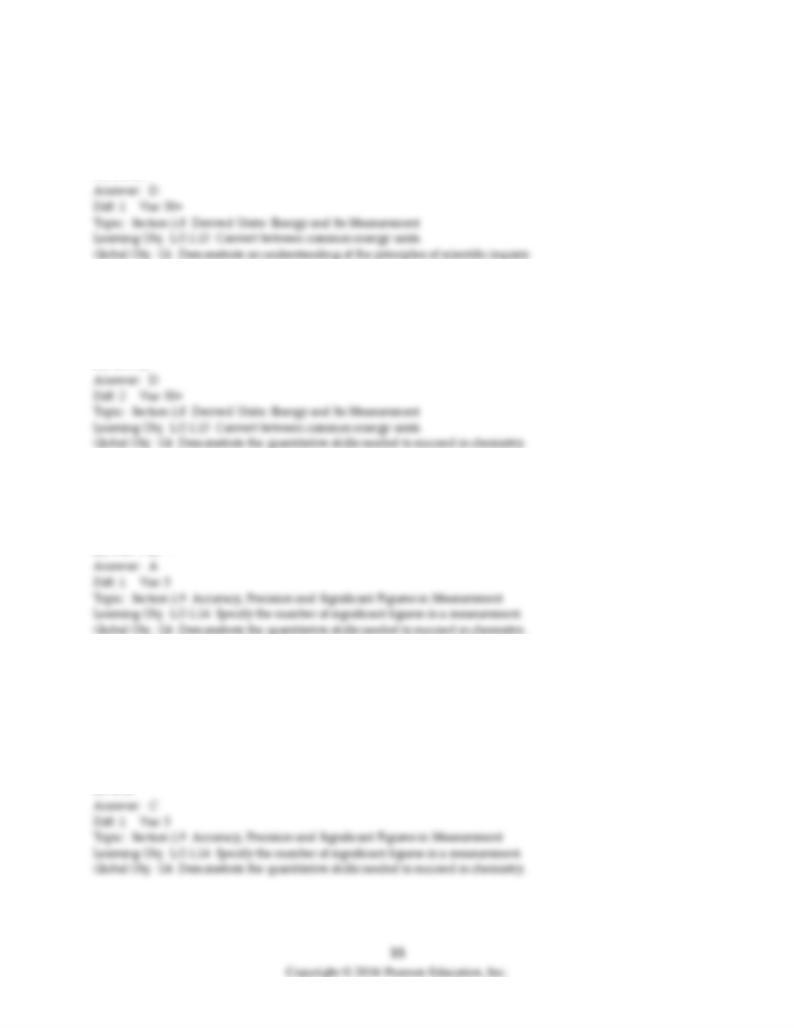
43) The nutritional calorie (abbreviated Cal) is equal to
A) 1 mcal.
B) 4.184 J.
C) 4.184 Mcal.
D) 1 kcal.
44) Which is the largest amount of heat?
A) 547 cal
B) 8.32 × 102 kcal
C) 6.66 × 102 J
D) 4.33 kJ
45) Which of the following numbers has the greatest number of significant figures?
A) 0.8010
B) 0.504
C) 742000
D) 9.05 × 1024
46) How many of the following numbers contain 3 significant figures?
0.509 1.050 0.0500 1.06 × 1024
A) one
B) two
C) three
D) four
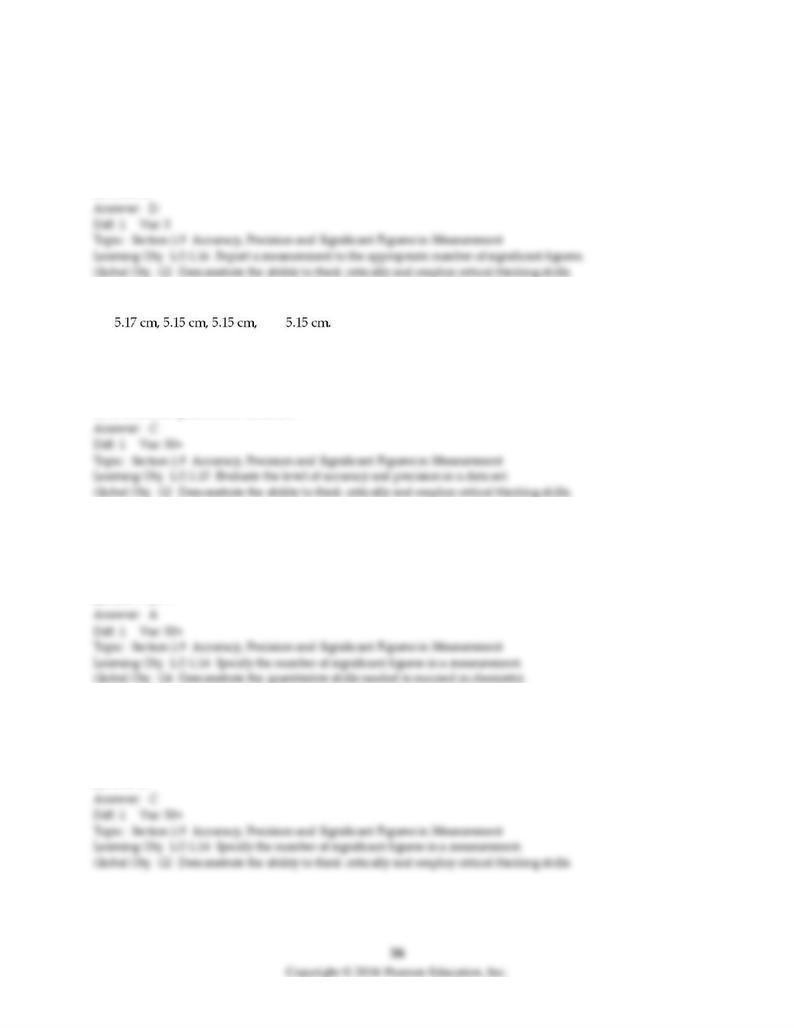
47) A methane molecule contains 1 atom of carbon. The number 1 represents how many significant
figures?
A) one
B) two
C) three
D) infinite
48) A student measured the diameter of a sphere and determined the average value. His measurements
are and If the true diameter is 6.18 cm, what can be said about the
student's results?
A) It is accurate and precise.
B) It is accurate but not precise.
C) It is precise but not accurate.
D) It is neither precise nor accurate.
49) Which of the following numbers has the greatest number of significant figures?
A) 0.5070
B) 0.201
C) 234000
D) 3.69 × 1024
50) Which of the following is an exact number?
A) 0.0.369 grams
B) 9.25 liters
C) 4 oranges
D) 3.60°C
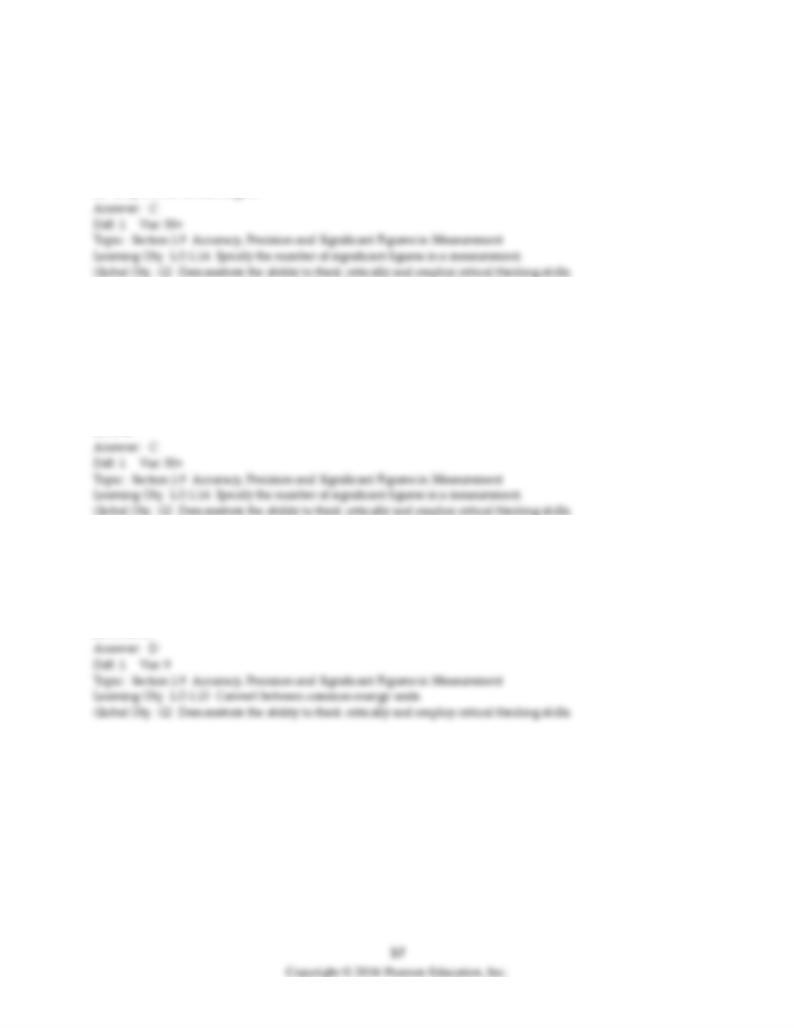
51) The measured mass of a sample of iron was 1.88 g. Which digit in the measurement has the least
certainty?
A) the first digit, 1
B) the middle digit, 8
C) the last digit, 8
D) They are all certain digits.
52) How many of the following numbers contain 3 significant figures?
0.105 5.600 0.0300 7.00 × 102
A) one
B) two
C) three
D) four
53) A heptane molecule contains 16 atoms of hydrogen. The number 16 represents how many significant
figures?
A) one
B) two
C) three
D) infinite
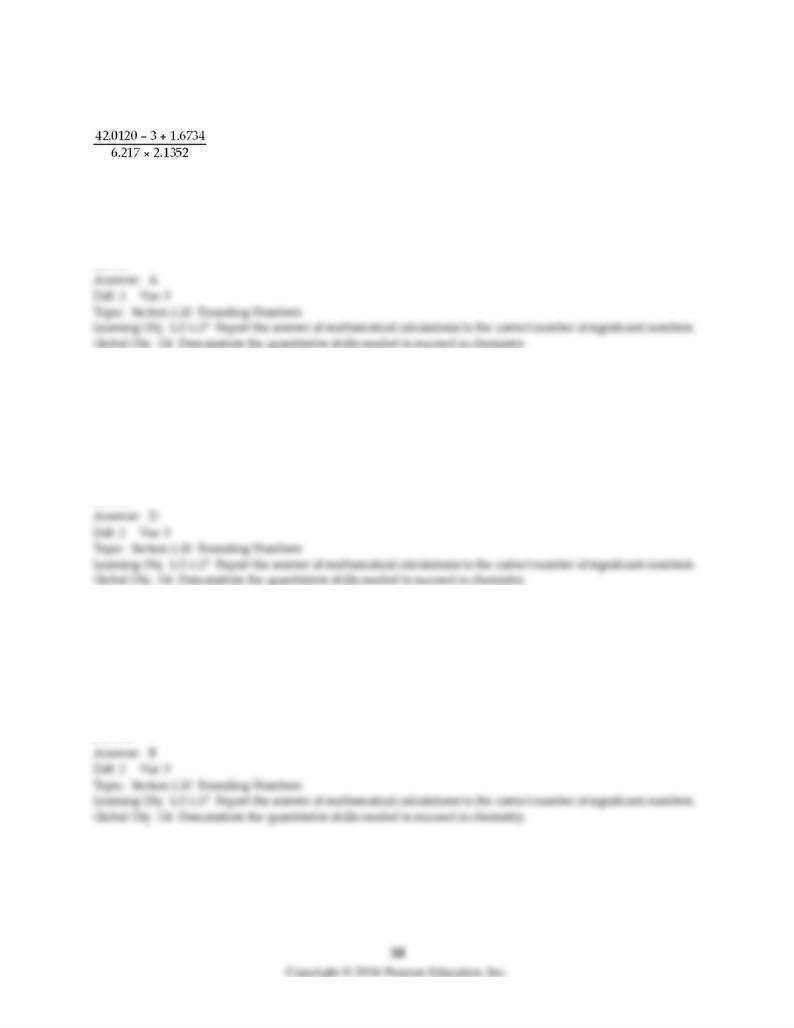
54) Consider the calculation:
Which of the following is the answer to this question with the correct number of significant digits?
A) 3
B) 3.0189
C) 3.019
D) 3.0
55) How many significant figures are there in the answer to the following problem?
(3.335 × 6.500) + 0.940 = ?
A) one
B) two
C) three
D) four
56) How many significant figures are there in the answer for the following problem?
23.1 + 0.5588 + 17 = ?
A) one
B) two
C) three
D) four
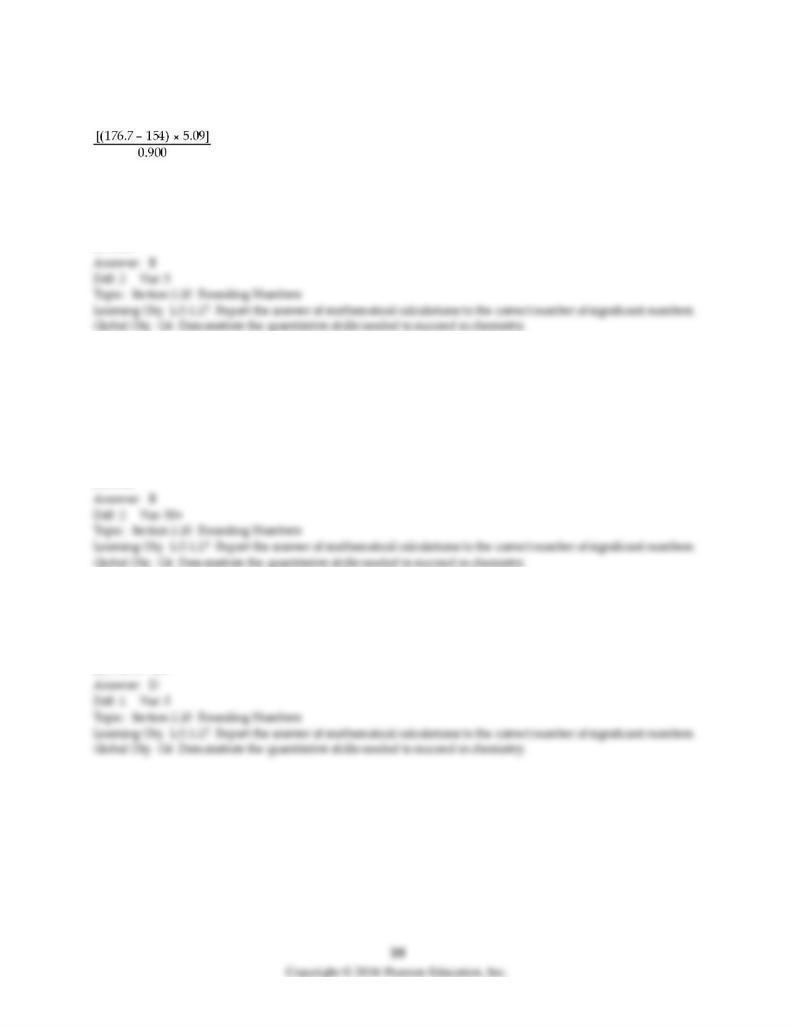
57) How many significant figures are there in the answer for the following problem?
= ?
A) one
B) two
C) three
D) four
58) How many significant figures are there in the answer for the following problem?
23.1 + 0.5848 + 11 = ?
A) one
B) two
C) three
D) four
59) Round off 00507506 to four significant figures.
A) 0051
B) 5076
C) 5100
D) 5.075 × 105
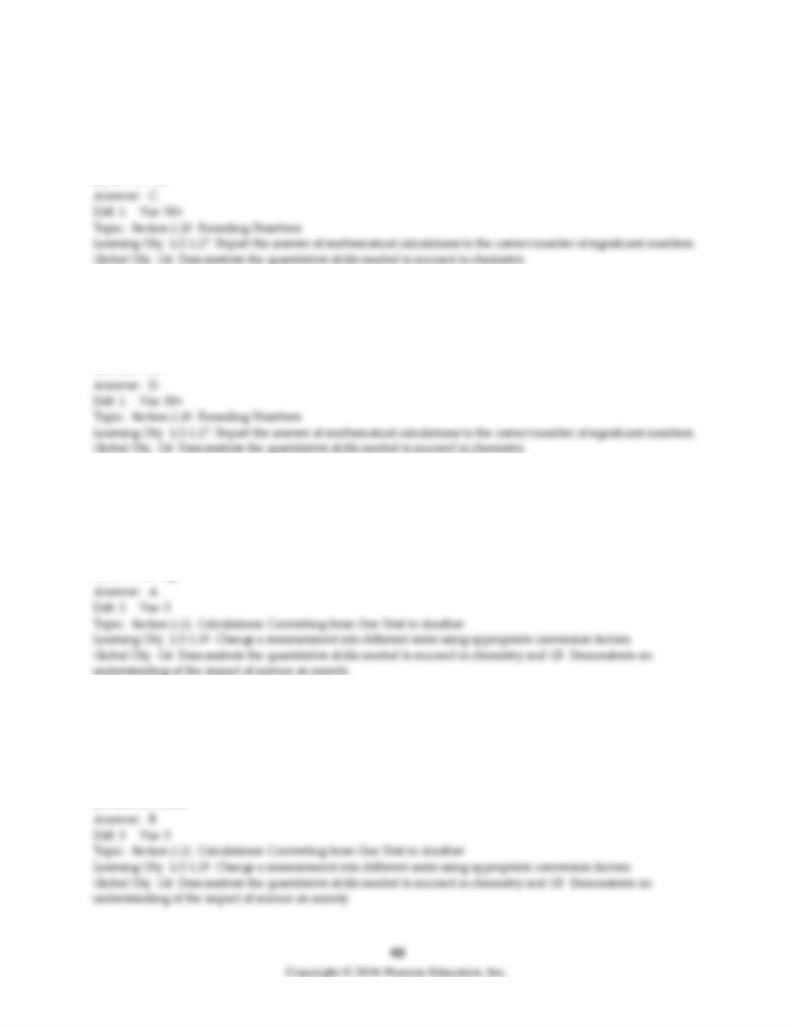
60) Round off 477,503 to four significant figures.
A) 4775
B) 4776
C) 4.775 × 105
D) 4.776 × 105
61) Round off 327,504 to three significant figures.
A) 327
B) 328
C) 3.27 × 105
D) 3.28 × 105
62) If 1.4% of the mass of a human body is calcium, how many kilograms of calcium are there in a 195-
pound man?
A) 1.2 kg Ca
B) 6.0 kg Ca
C) 1.2 × 102 kg Ca
D) 6.0 × 102 kg
63) A fishing boat accidentally spills 6.0 barrels of diesel oil into the ocean. Each barrel contains 42
gallons. If the oil film on the ocean is 2.5 × 102 nm thick, how many square meters will the oil slick cover?
A) 3.8 × 10-3 m2
B) 3.8 × 106 m2
C) 3.8 × 107 m2
D) none of these
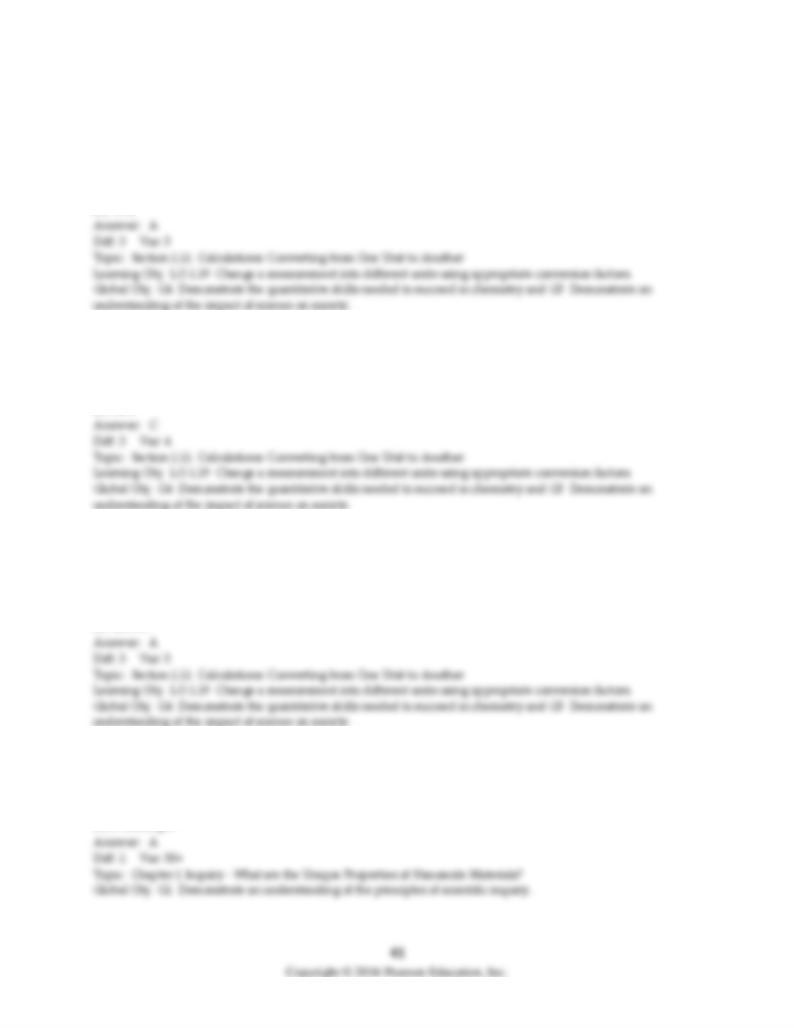
64) Because of the high heat and low humidity in the summer in Death Valley, California, a visitor
requires about one quart of water for every two miles traveled on foot. Calculate the approximate
number of liters required for a person to walk 15 kilometers in Death Valley.
A) 4.4 L
B) 18 L
C) 46 L
D) 70 L
65) A car drives 80 km/h. If the car is driven for 122 minutes, how many miles has the car traveled?
A) 262
B) 364,000
C) 101
D) 24.4
66) The output of a pendant manufacturer is 4335 pounds per week. If each pendant weighs 0.0133
pounds, how many pendants does the manufacturer make in one day?
A) 2,282,000
B) 324,700
C) 58
D) 46,560
67) An atom can be seen by
A) an atomic force microscope.
B) a nucleon microscope.
C) an optical microscope.
D) a telescope.

68) Identify the smallest item.
A) the width of human hair
B) a white blood cell
C) a virus
D) a sugar
69) Liquids A, B, and C are insoluble in one another (i.e., they are immiscible). A, B, and C have densities
of and respectively. Which drawing represents the result of placing
all three liquids into the same graduated cylinder?
A) drawing (a)
B) drawing (b)
C) drawing (c)
D) drawing (d)
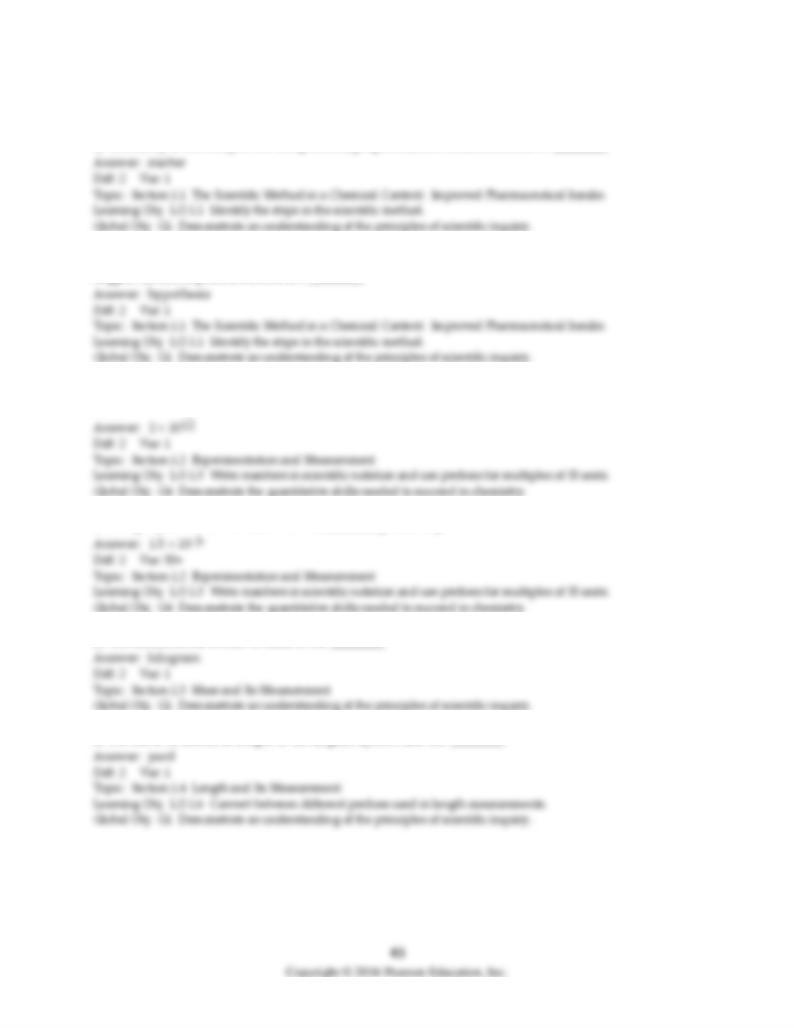
1.3 Short Answer Questions
1) Chemistry is the study of the composition, properties, and transformations of ________.
2) A preliminary explanation of the results of many experiments that can be used to make predictions and
suggest further experimentations is a ________.
3) Using exponential notation, there are ________ bytes of memory are contained in a 2 TB external hard
drive.
4) Using exponential notation, there are ________ g in 1.5 mg.
5) The fundamental SI unit of mass is the ________.
6) The meter is closest in length to the English system unit the ________.
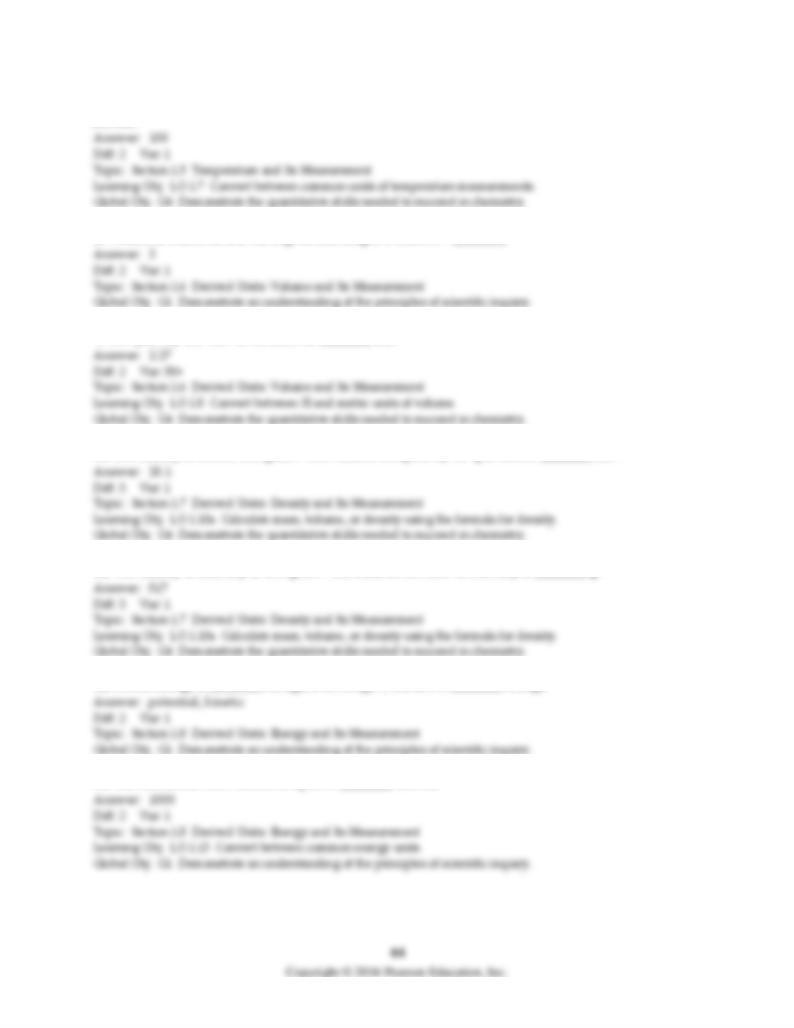
7) The difference between the boiling point and freezing point of water is 100°C, which is ________
kelvins.
8) Volume is a derived unit having the unit lengthx, where x = ________.
9) The quantity 2.27 cm3 is the same as ________ mL.
10) The density of lead is 11.3 g/cm3. The volume occupied by 227 g of lead is ________ cm3.
11) The density of mercury is 13.6 g/cm3. The mass of 38.0 cm3 of mercury is ________ g.
12) Stored energy is ________ energy, and energy of motion is ________ energy.
13) The nutritionist unit Calorie is equal to ________ calories.
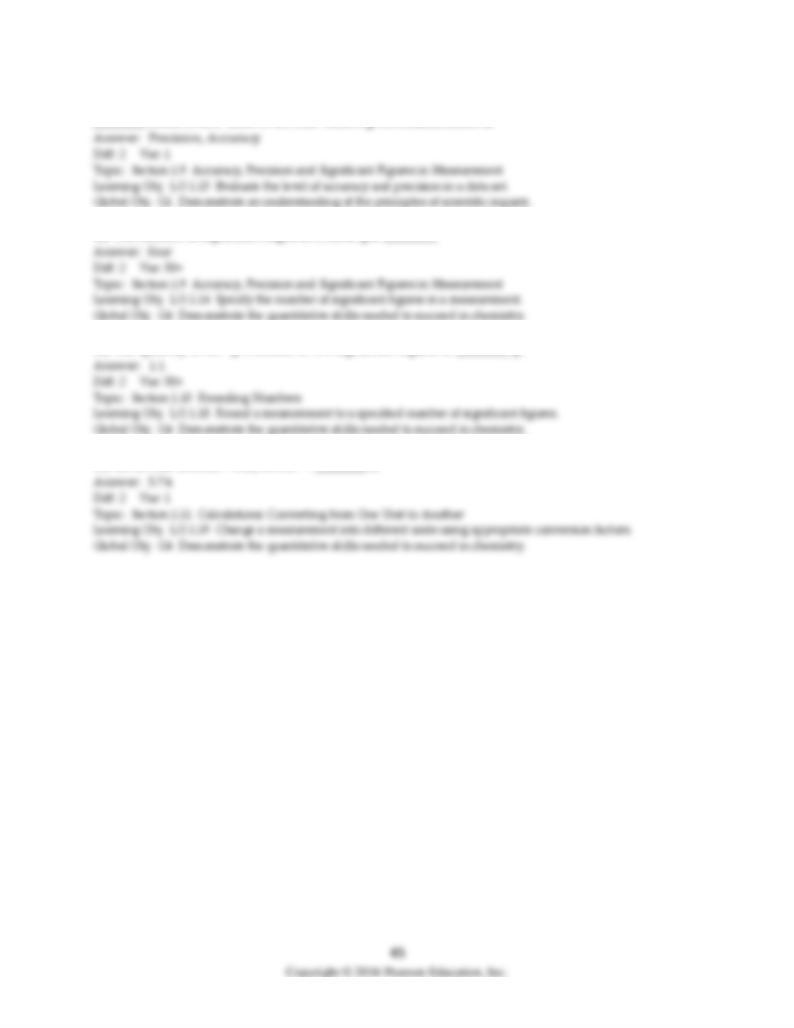
14) ________ refers to how well a number of independent measurements agree with one another, whereas
________ refers to how close to the true value a given measurement is.
15) The number of significant digits in 0.01810 g is ________.
16) The quantity 1.0857 qt rounded to two significant figures is ________ qt.
17) Given that 2.54 cm = 1 in, 350 in3 = ________ L.